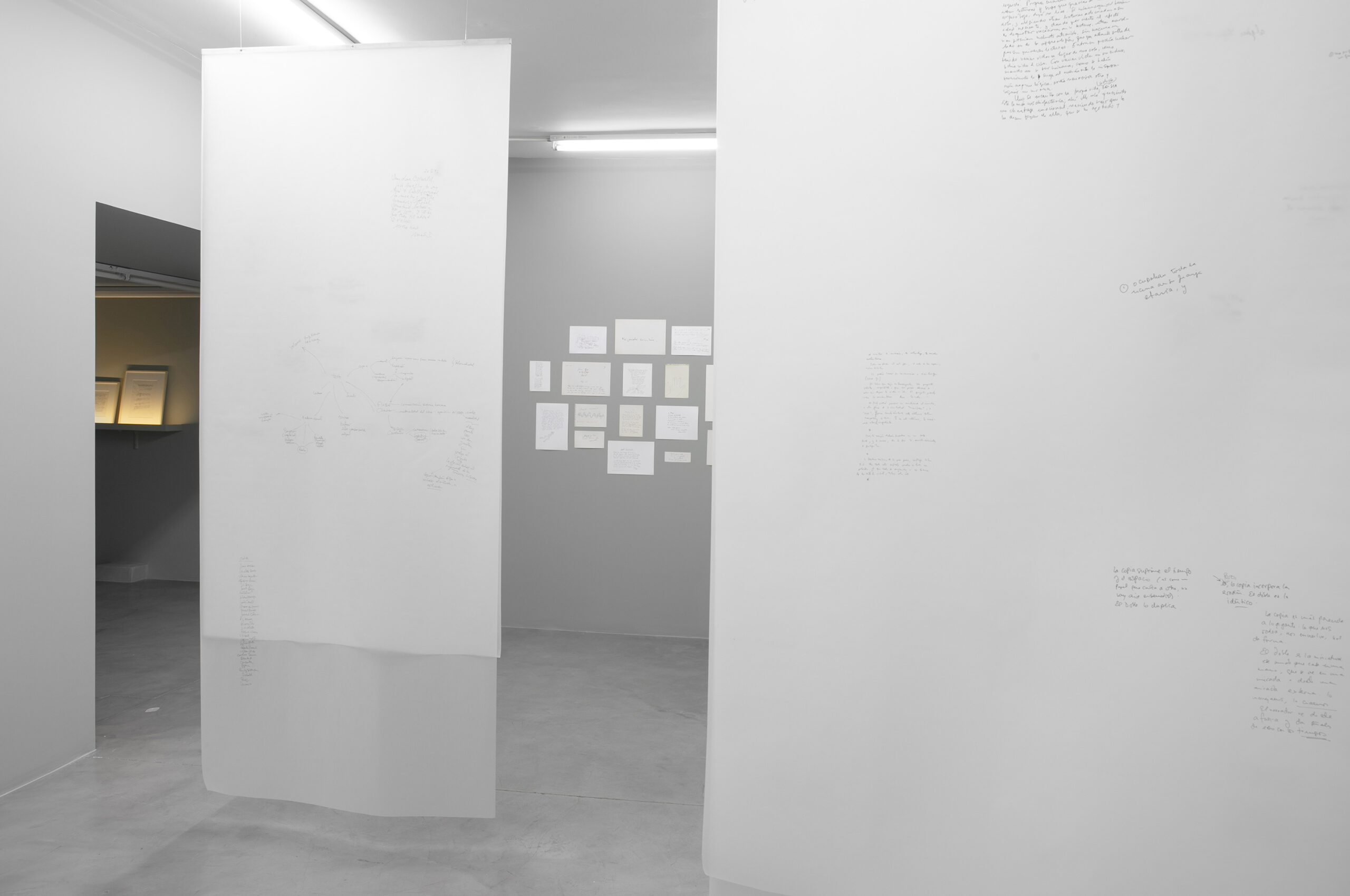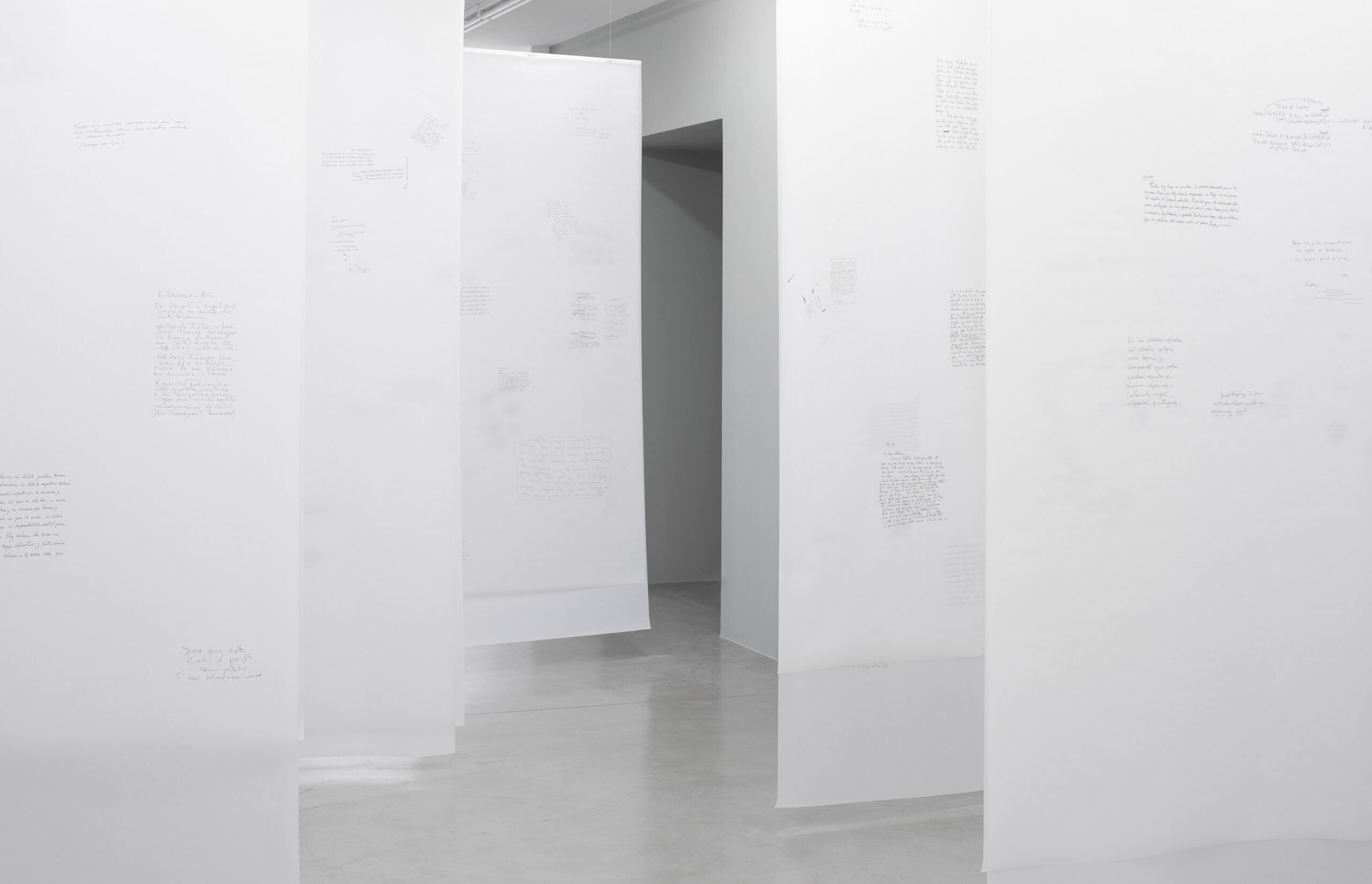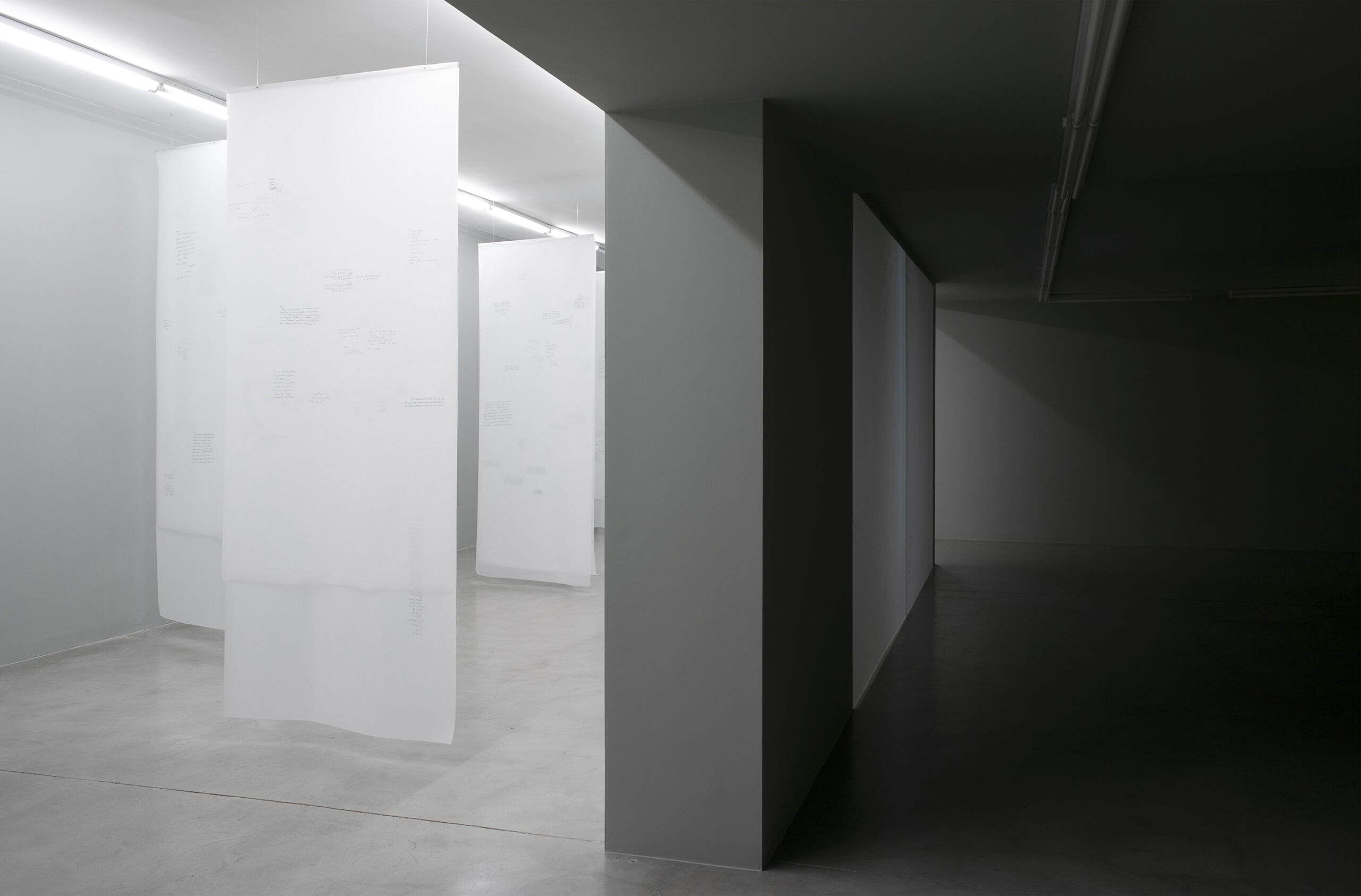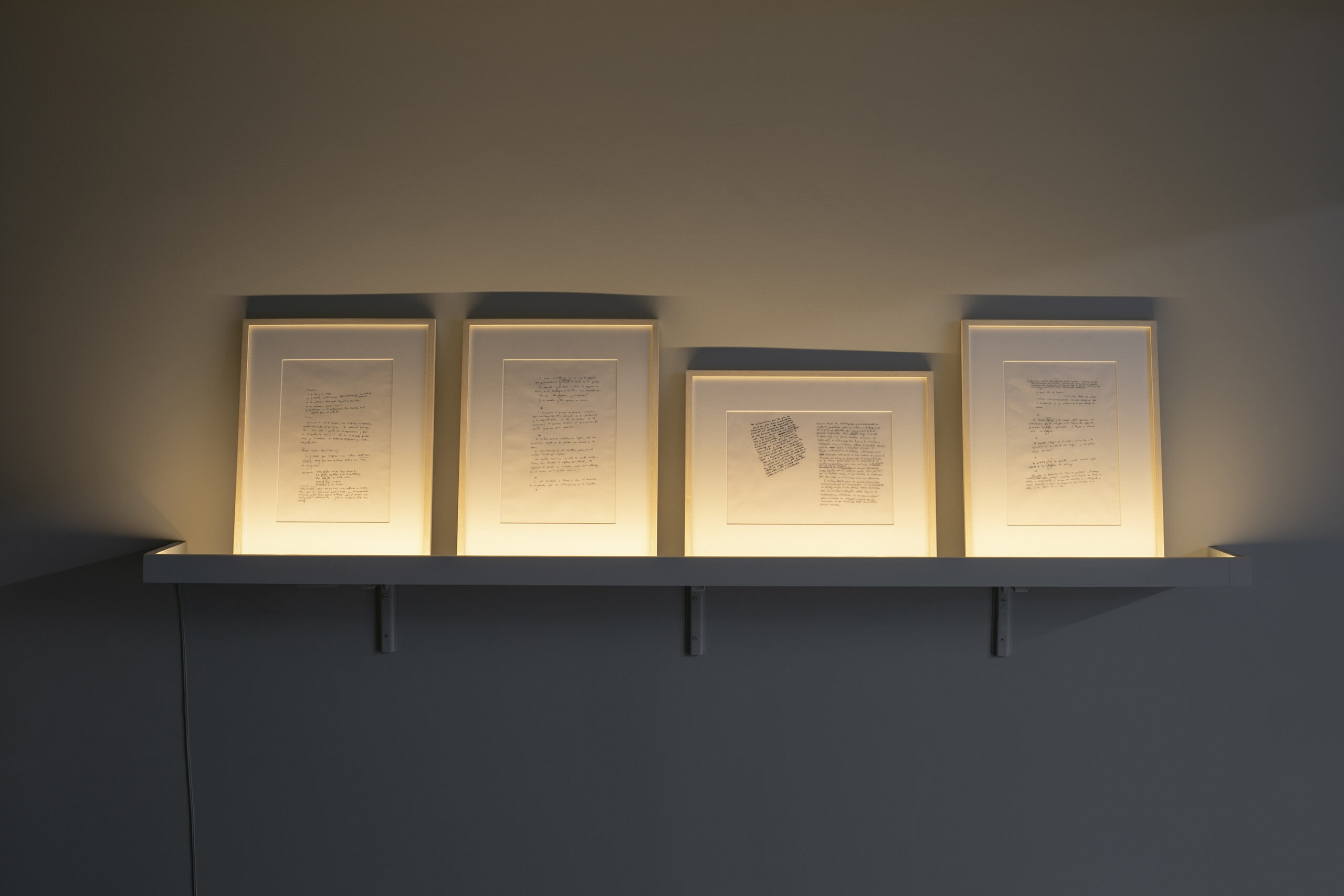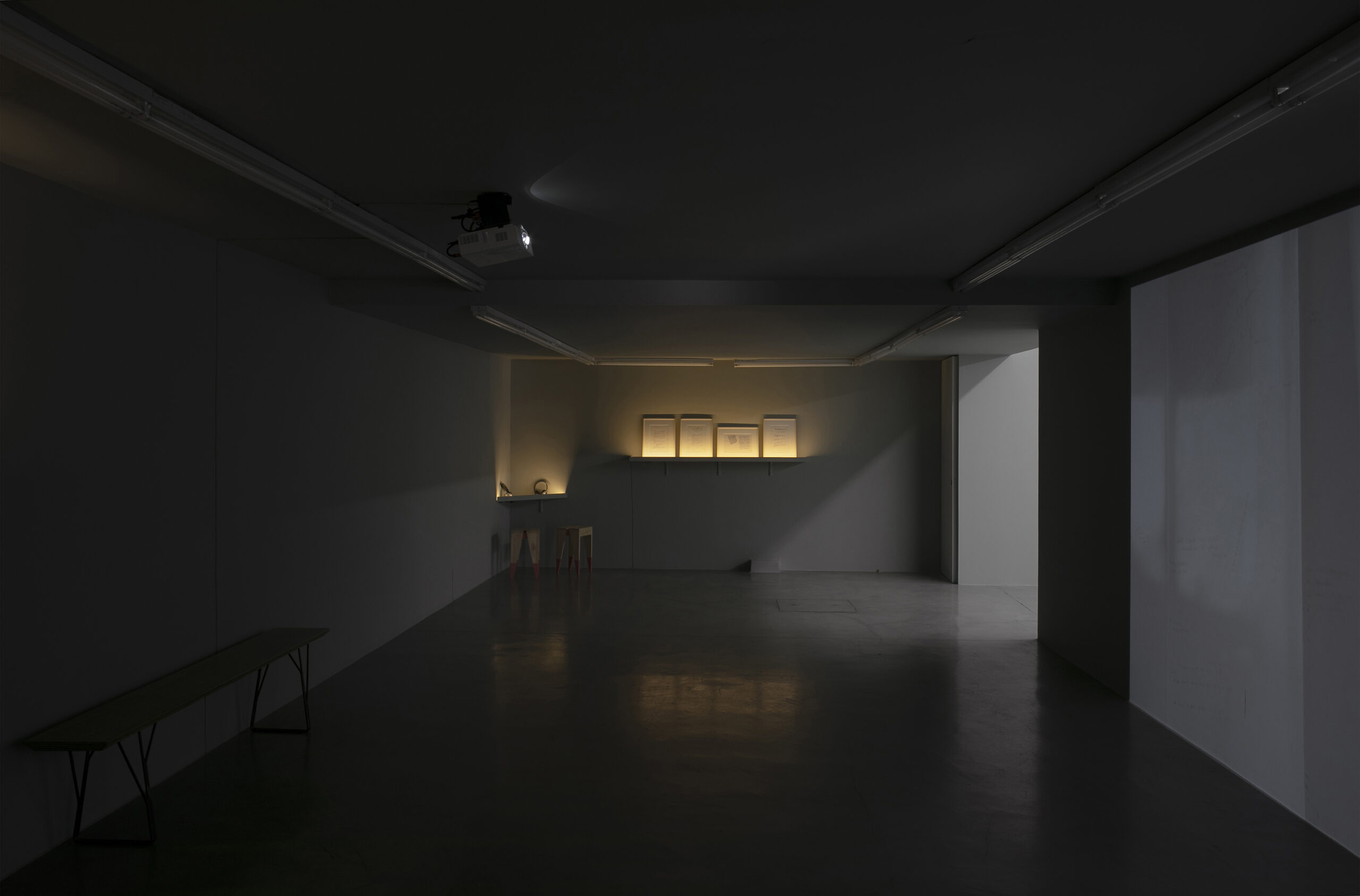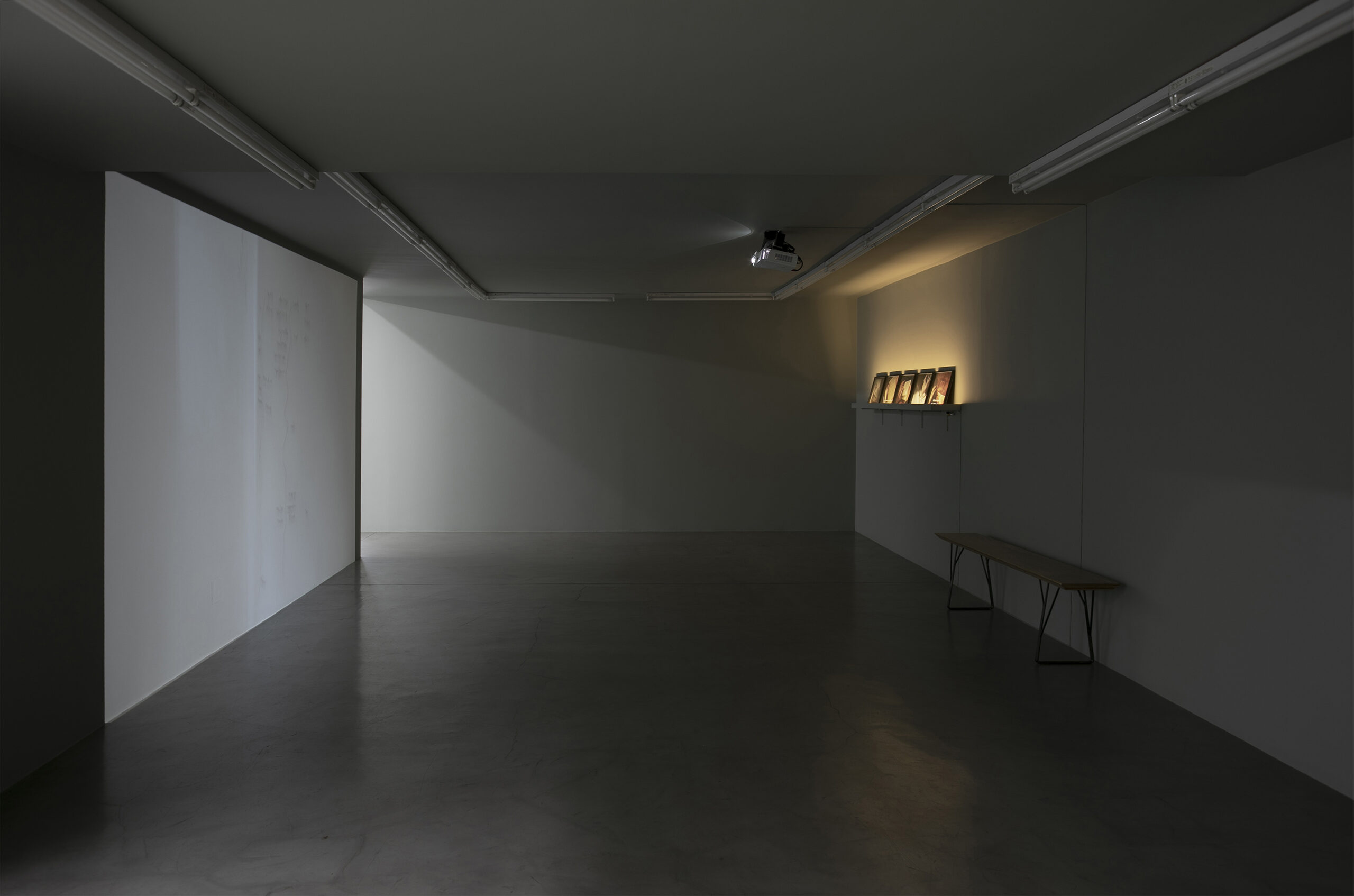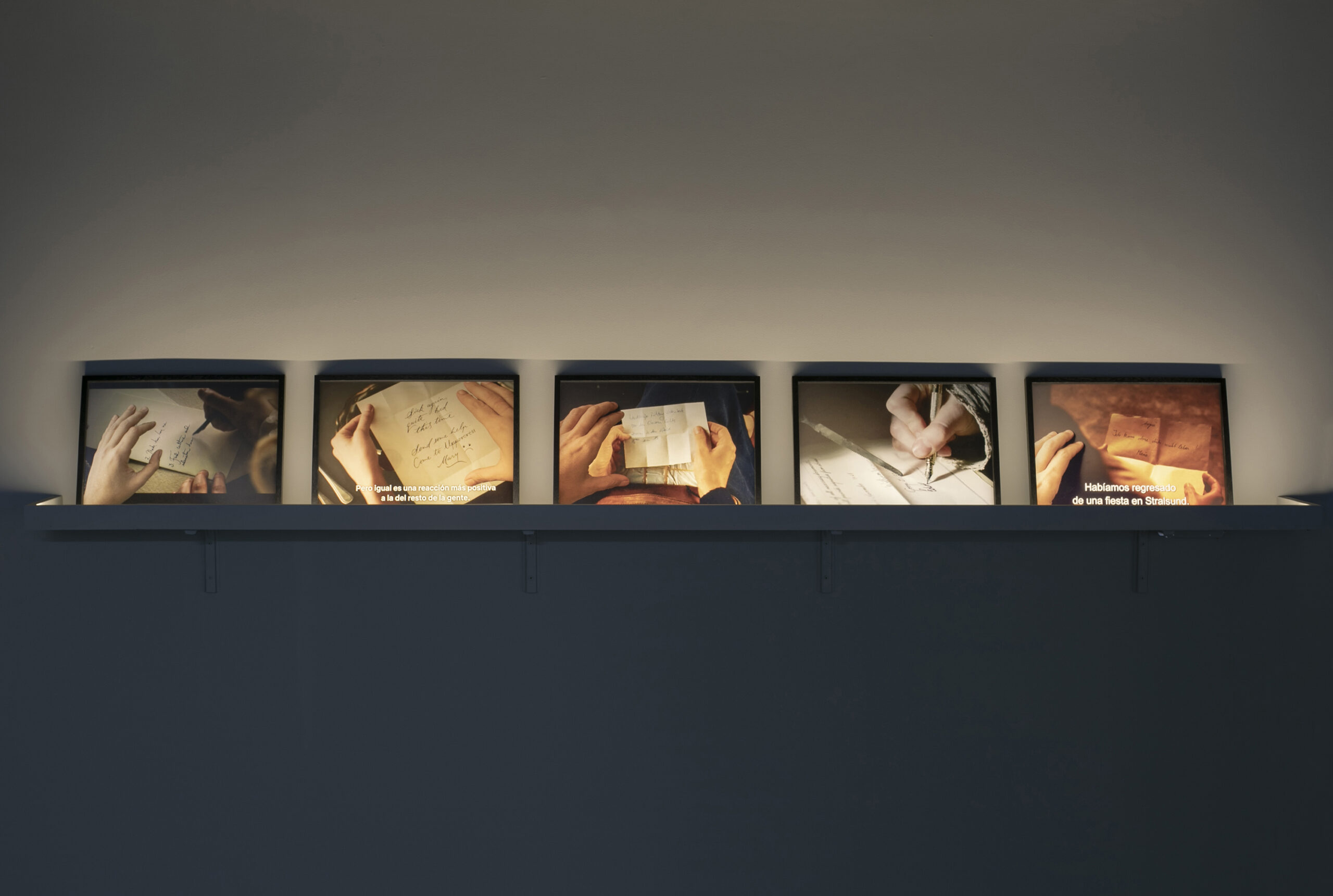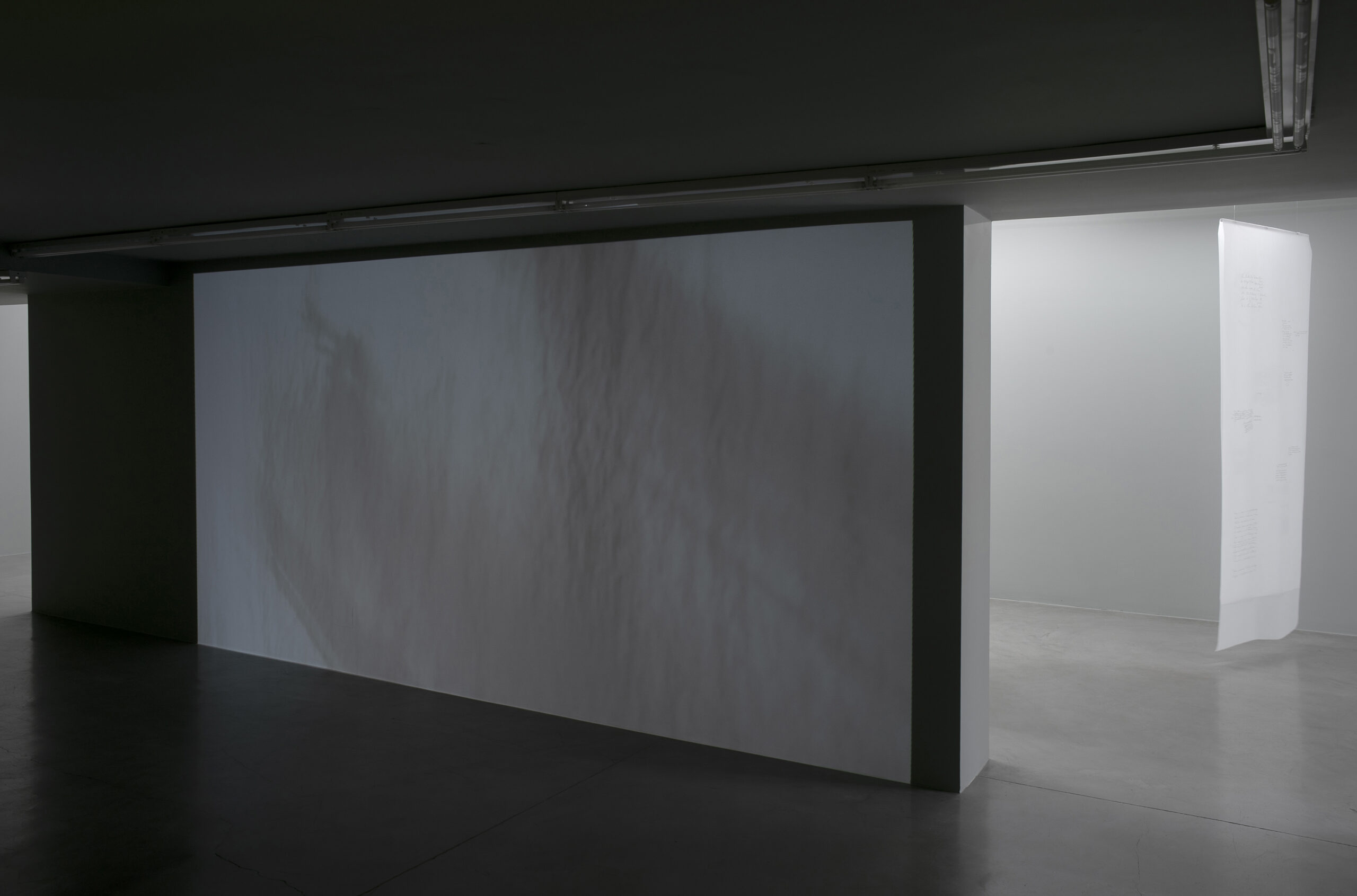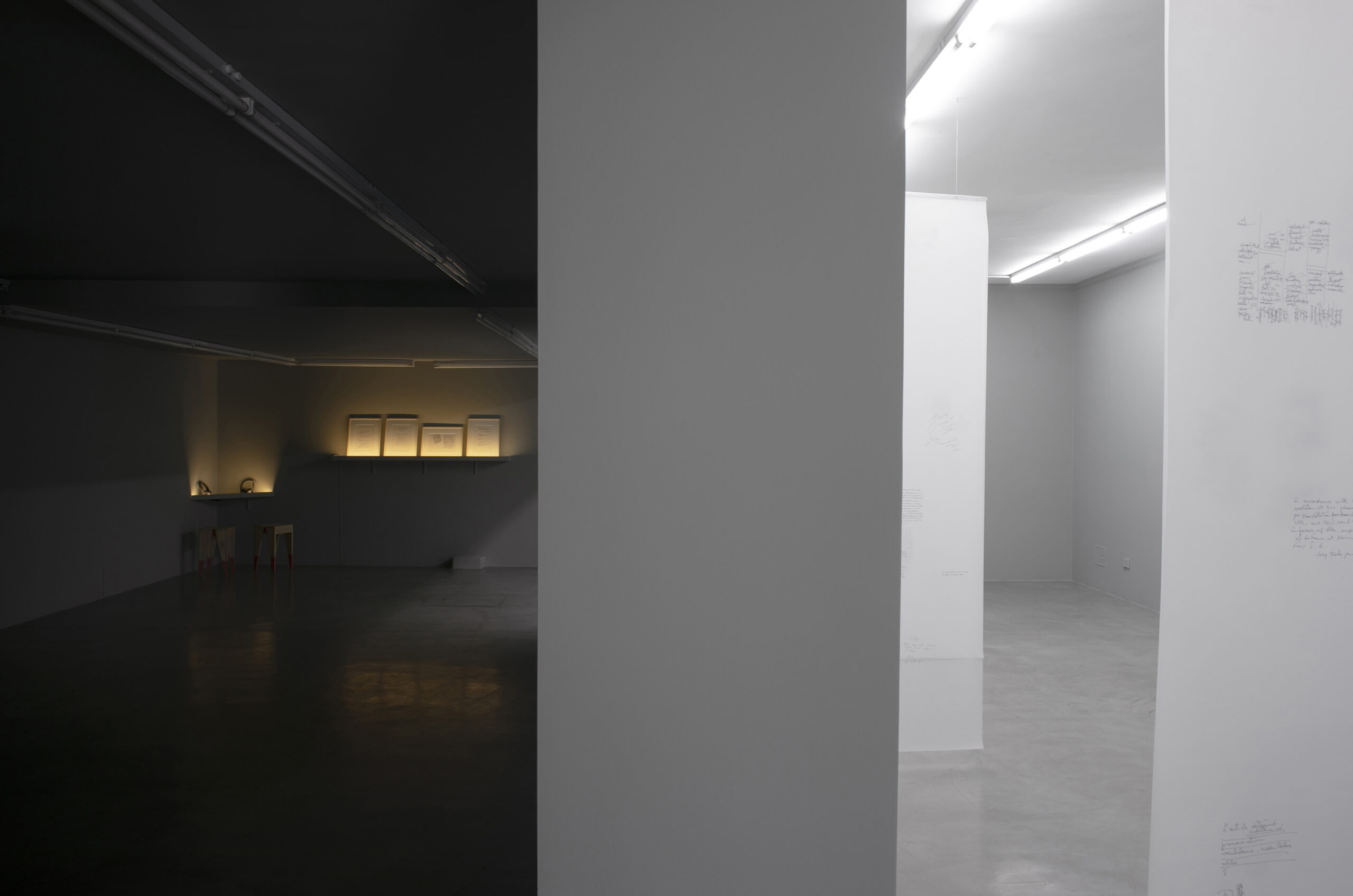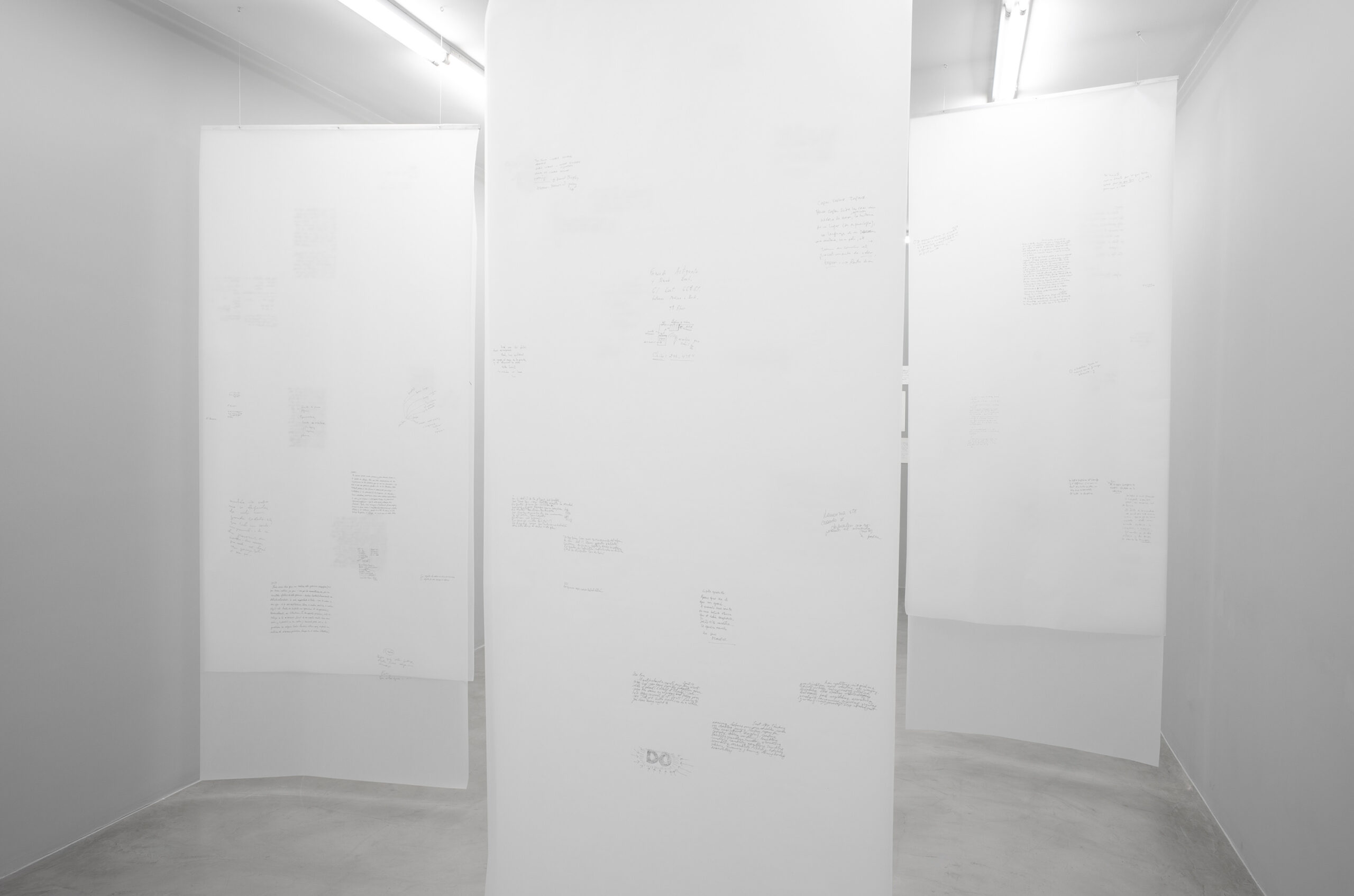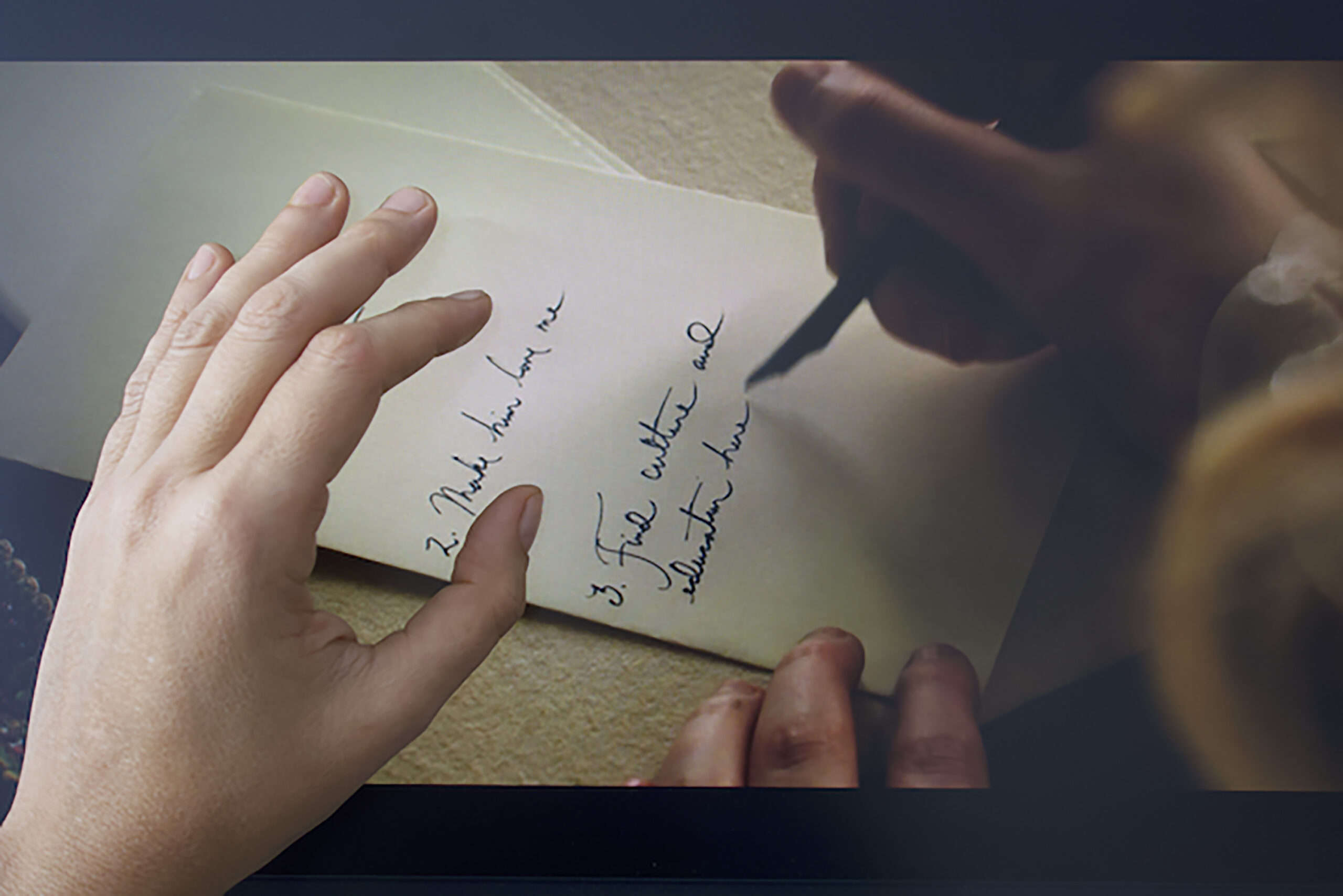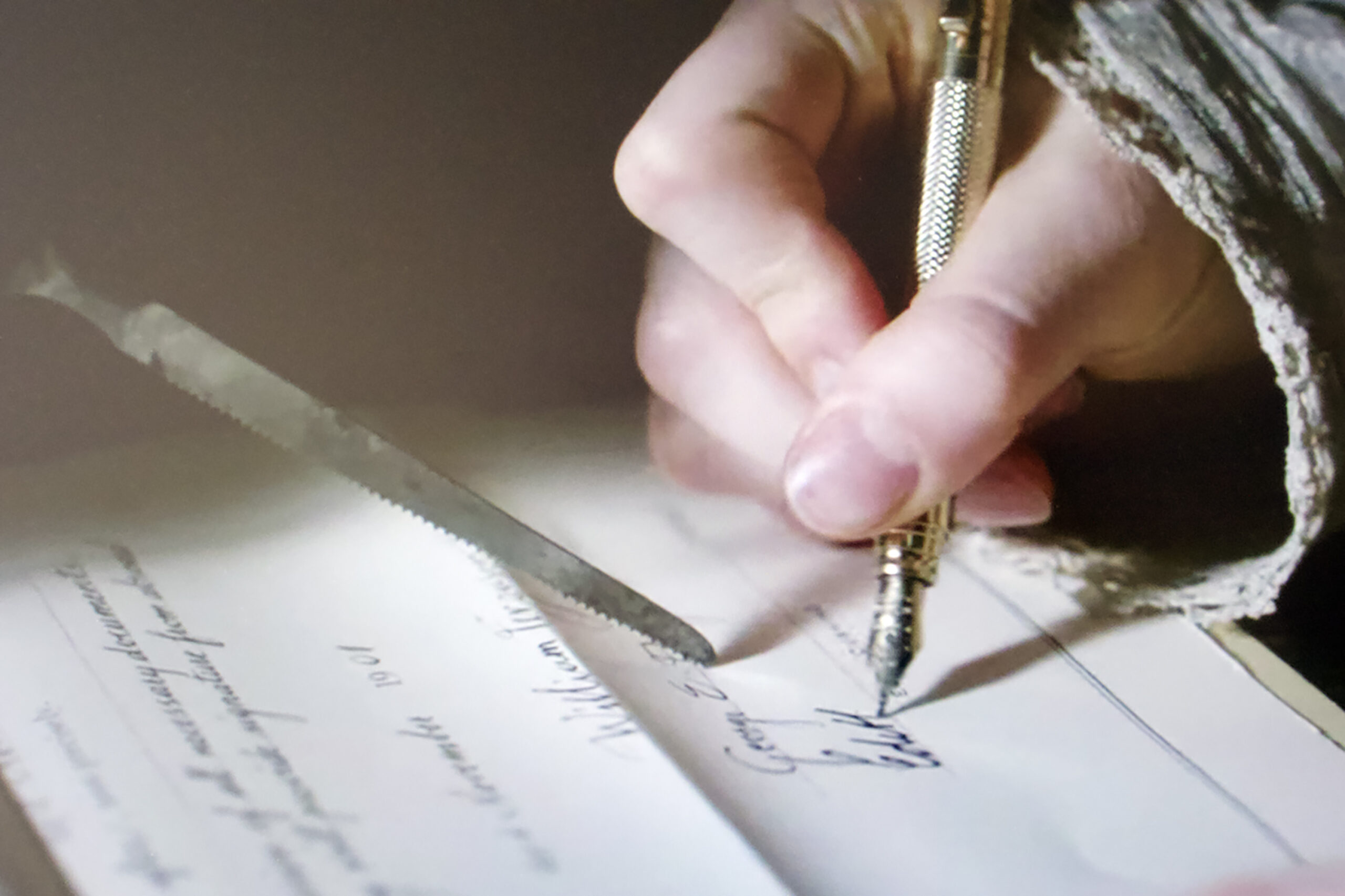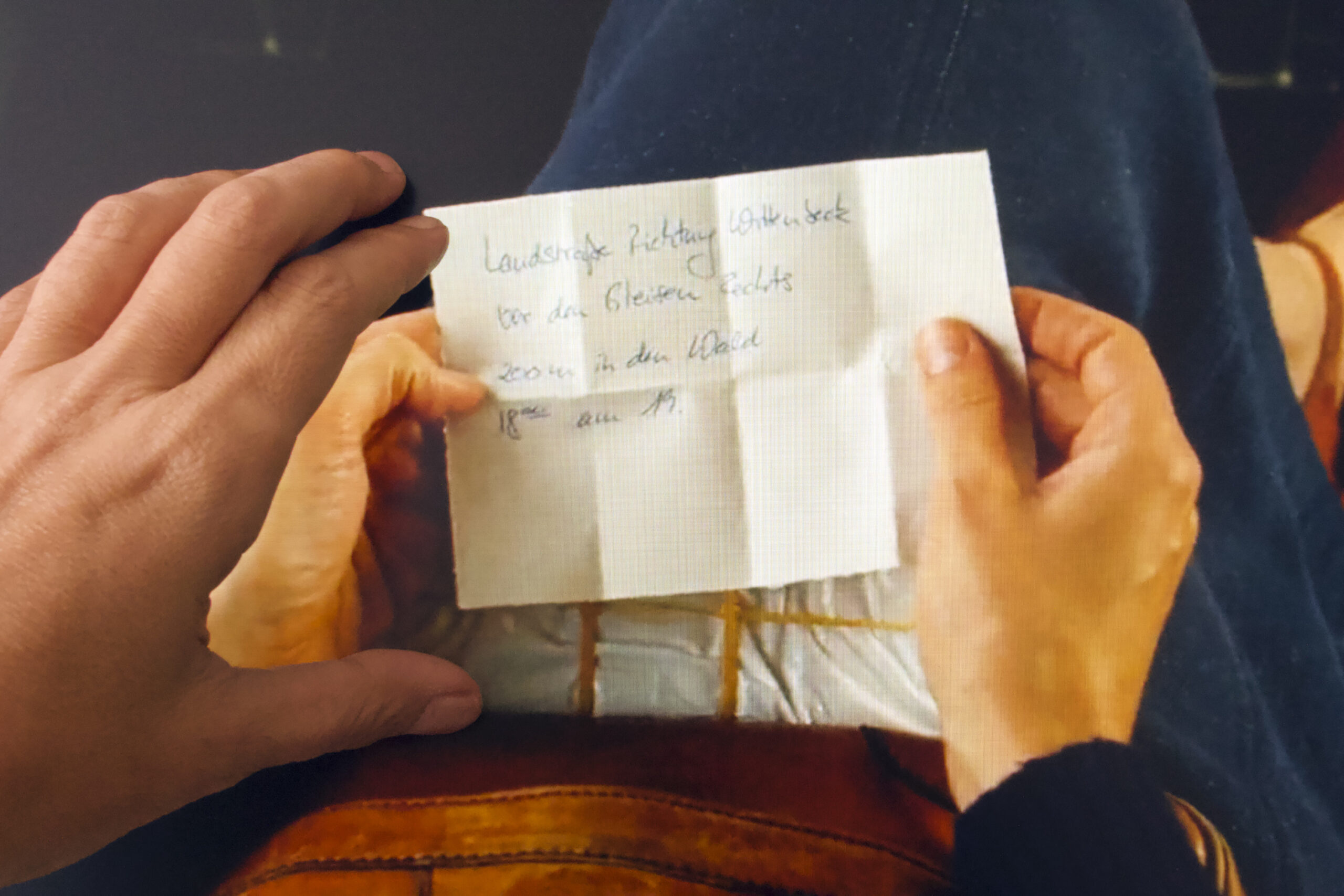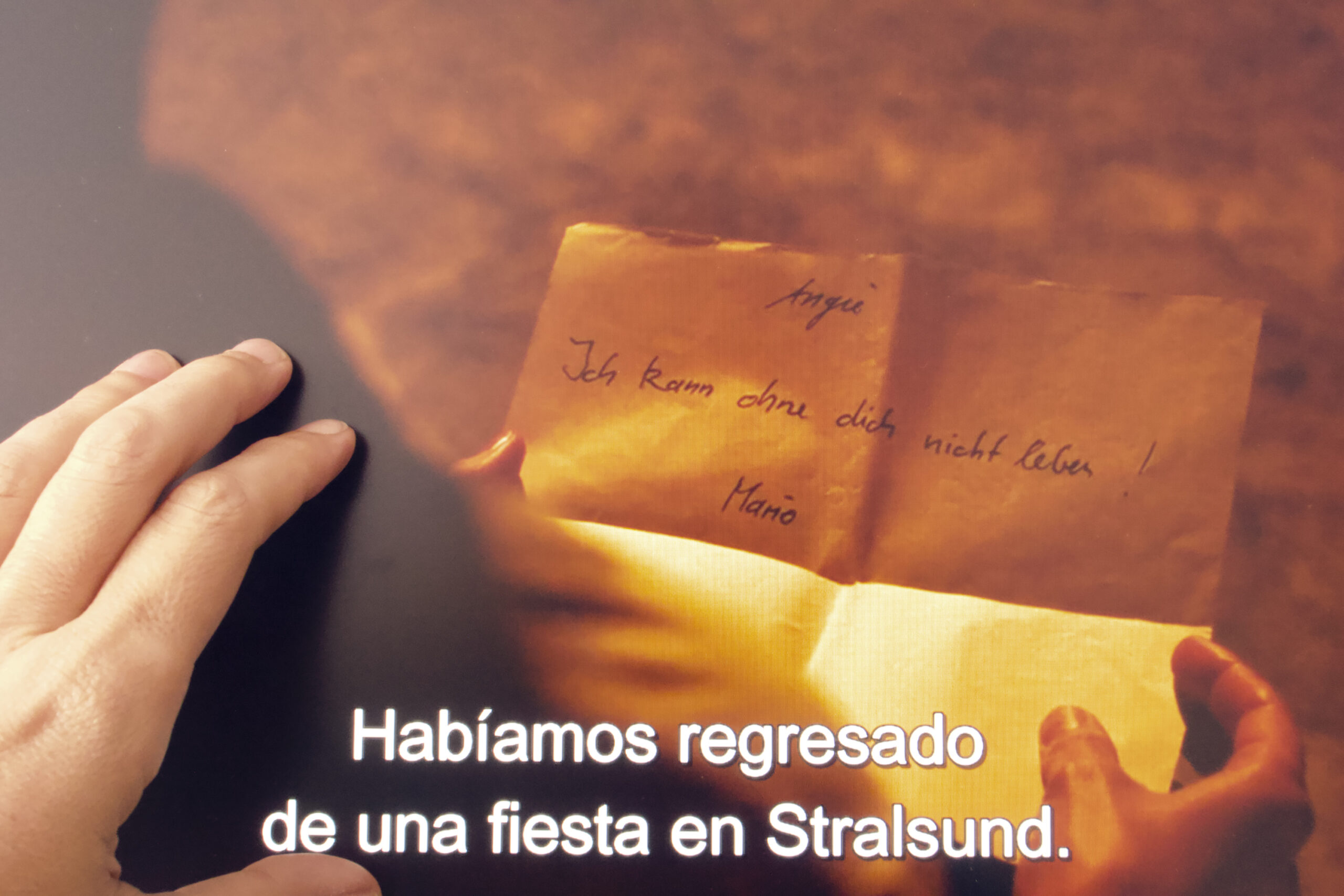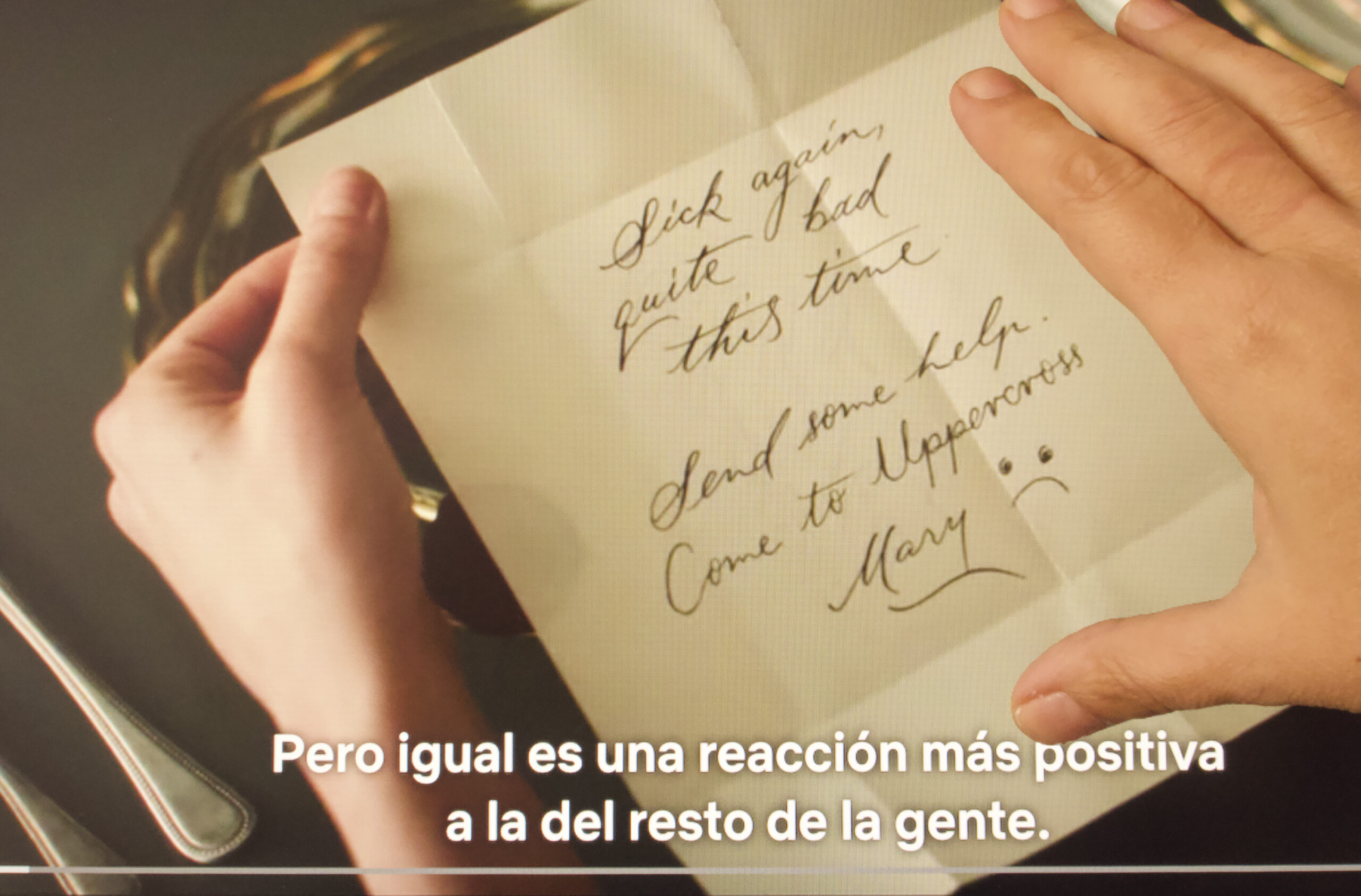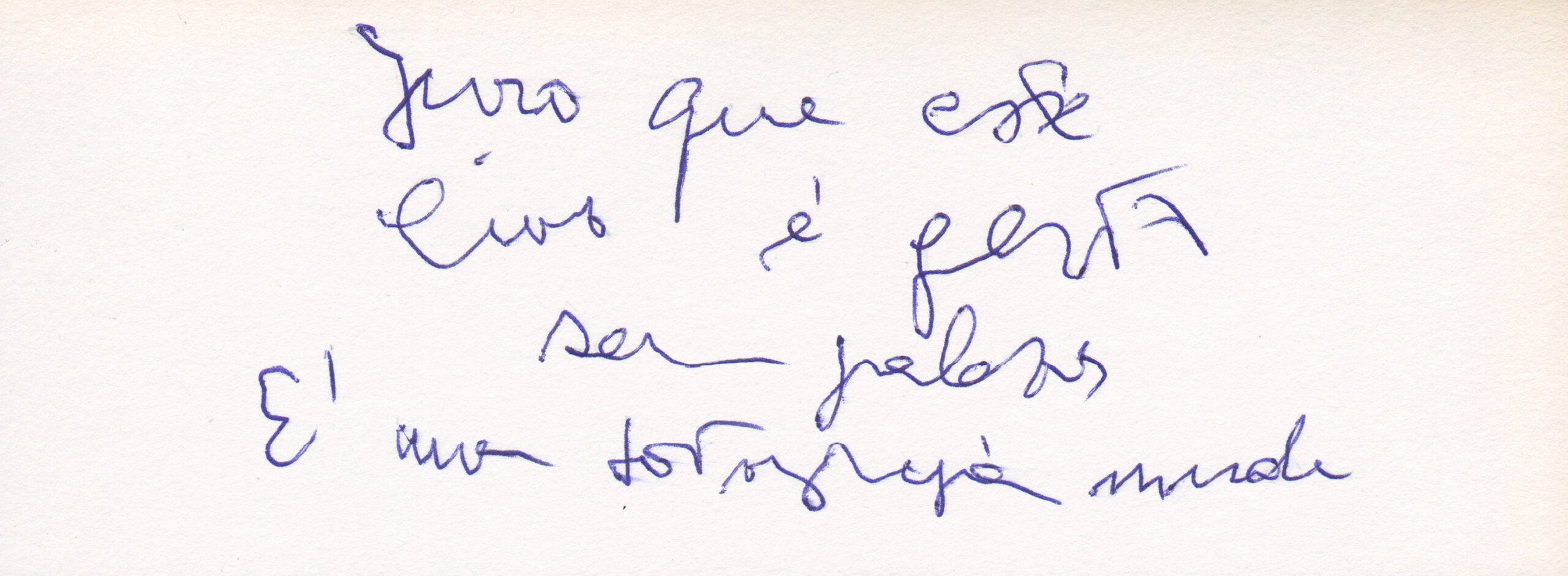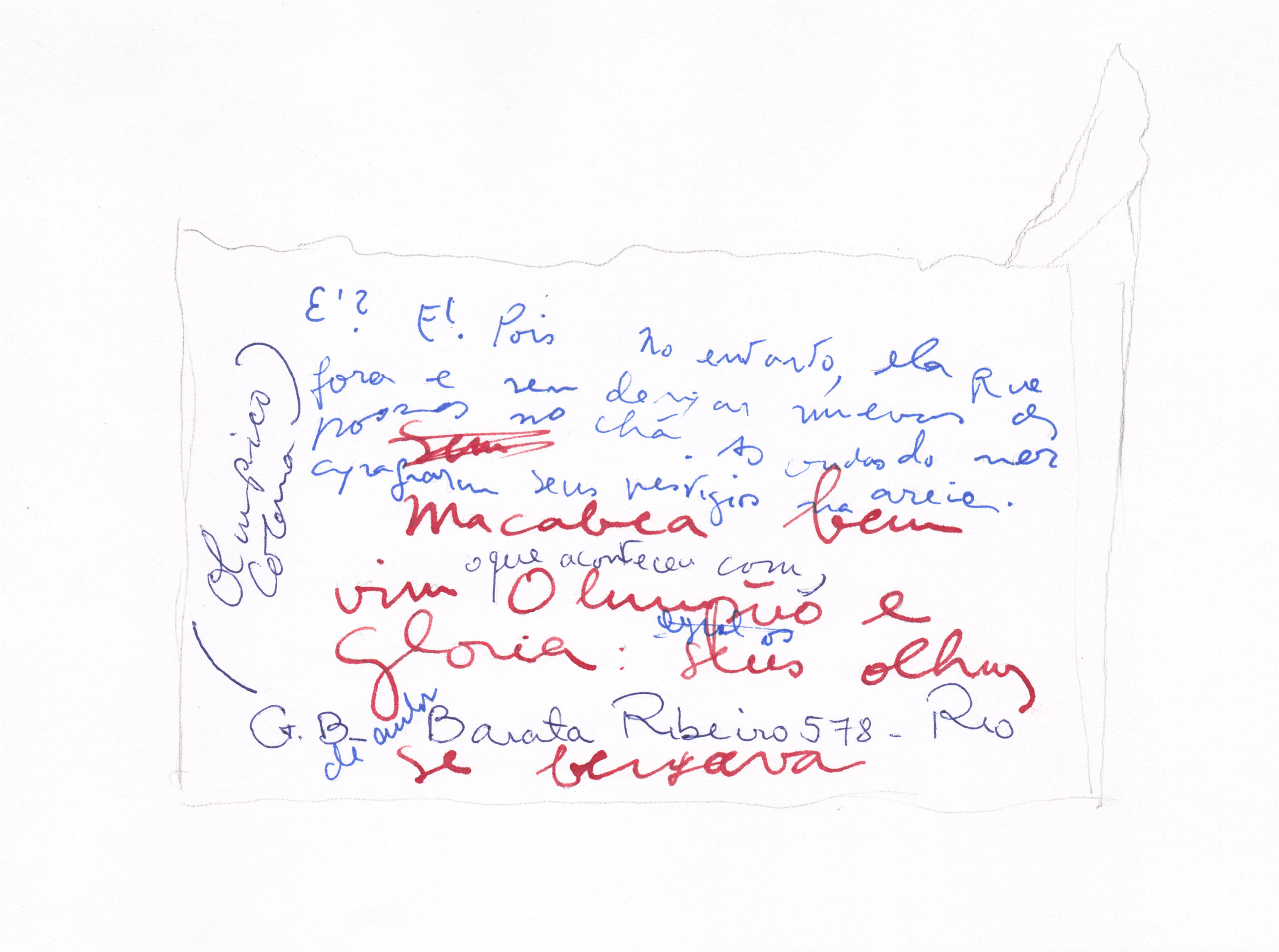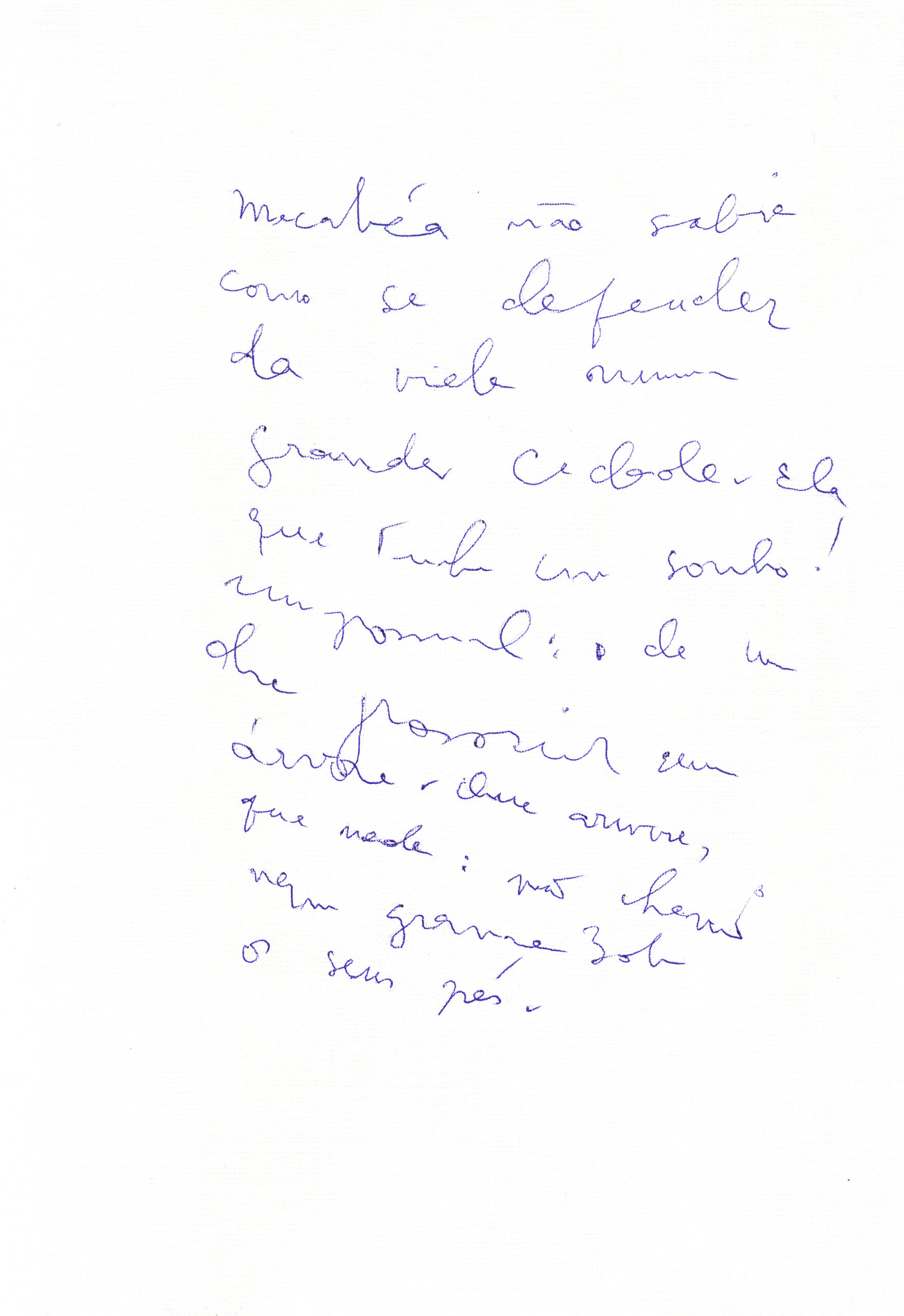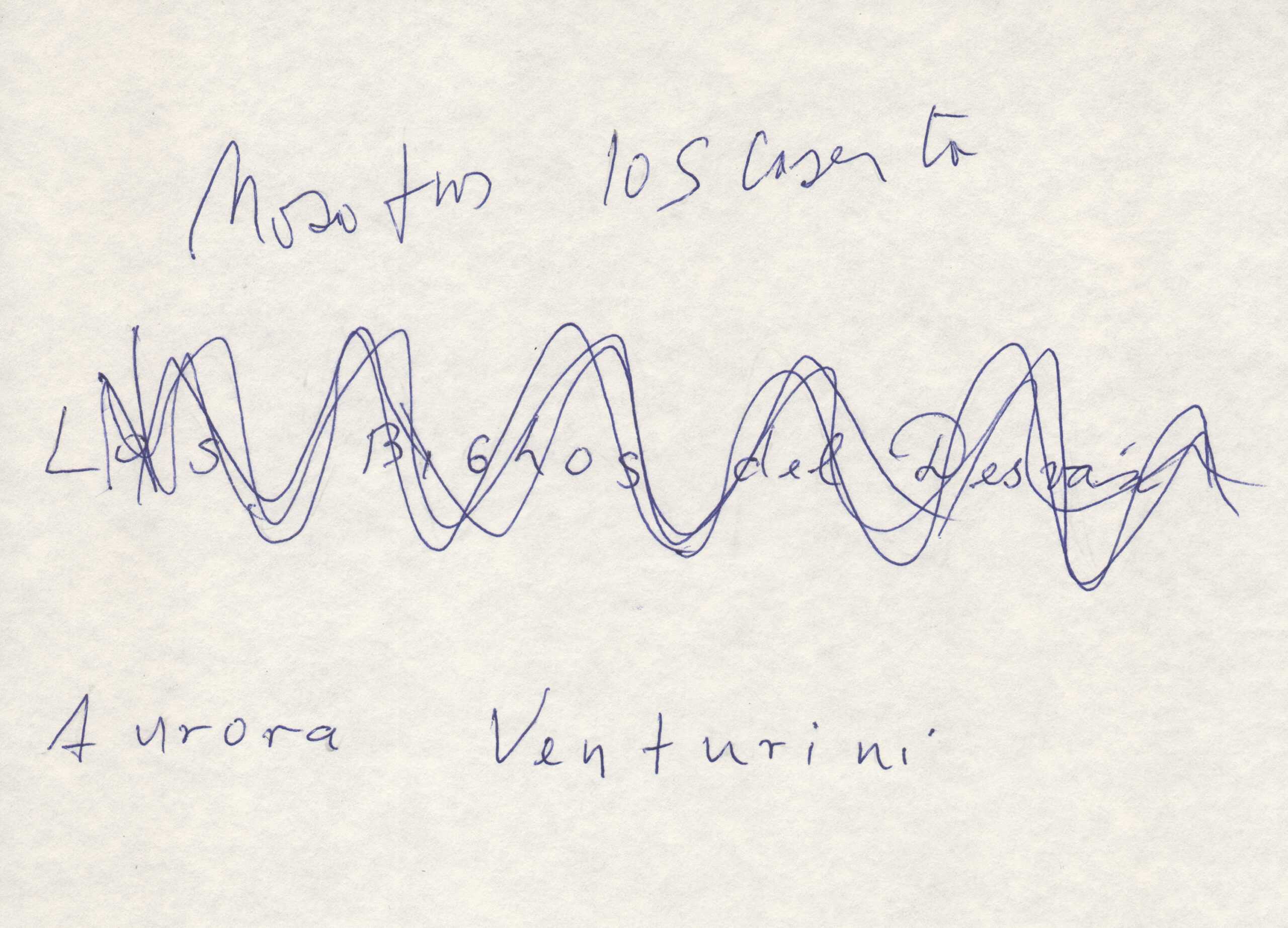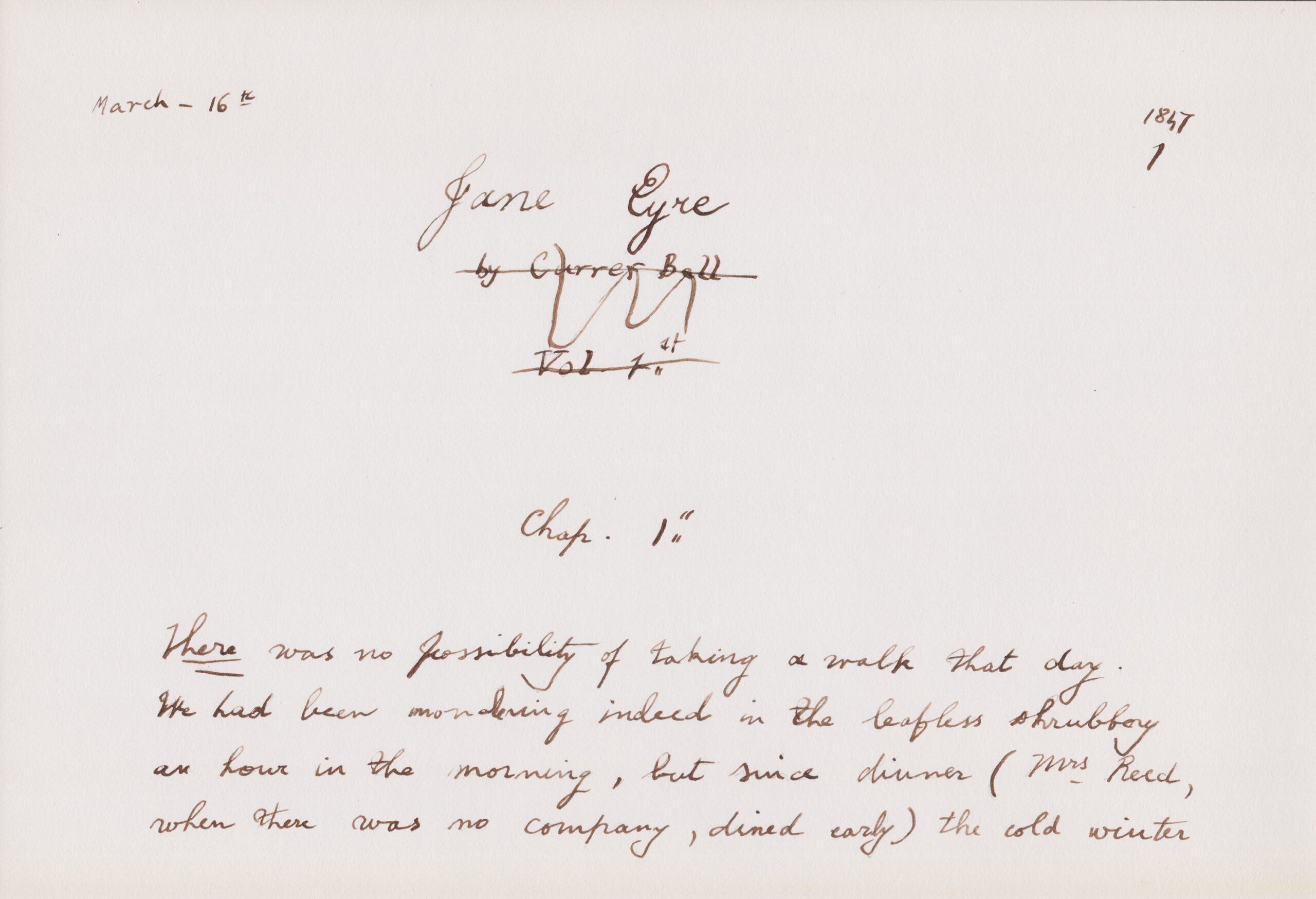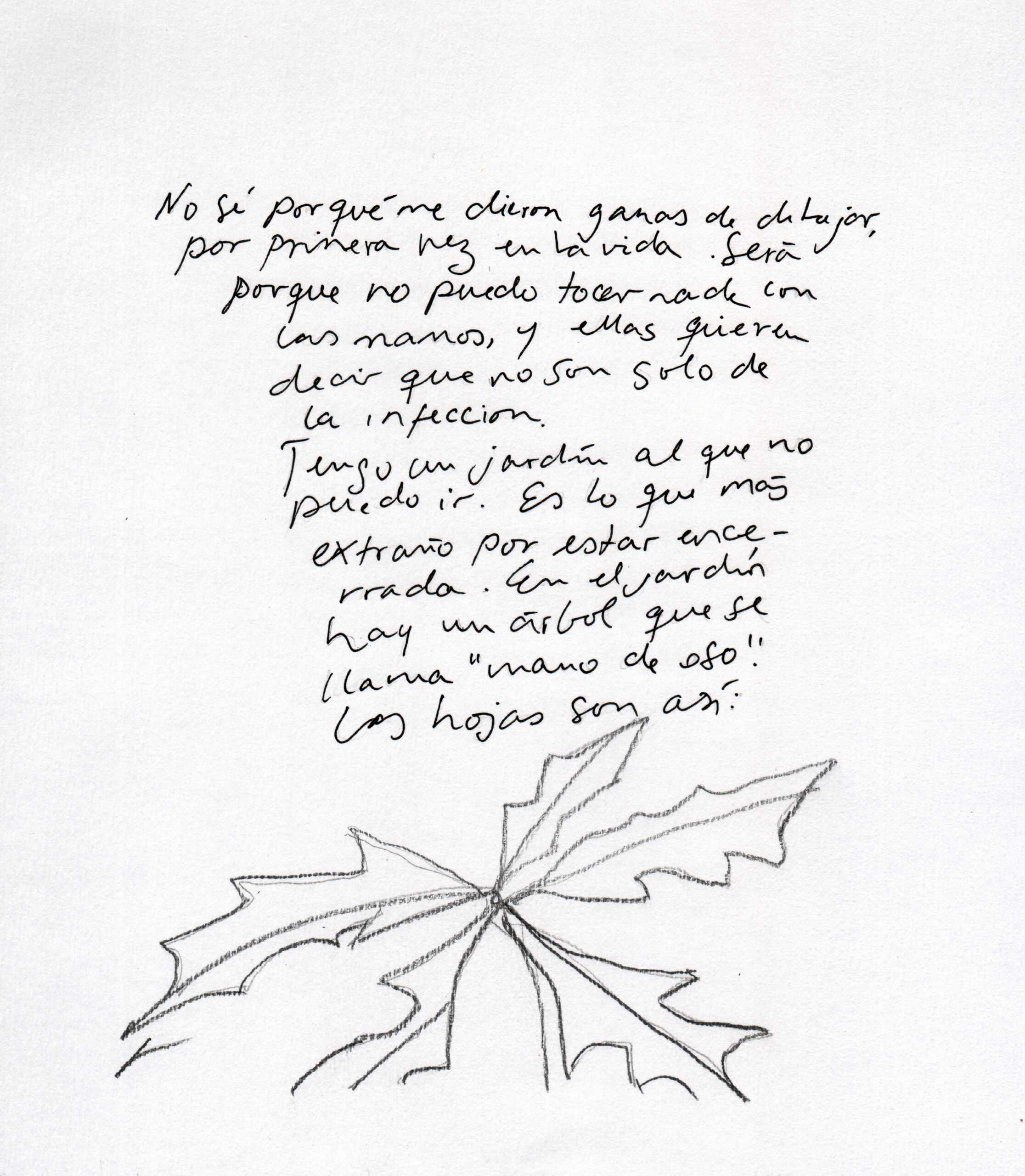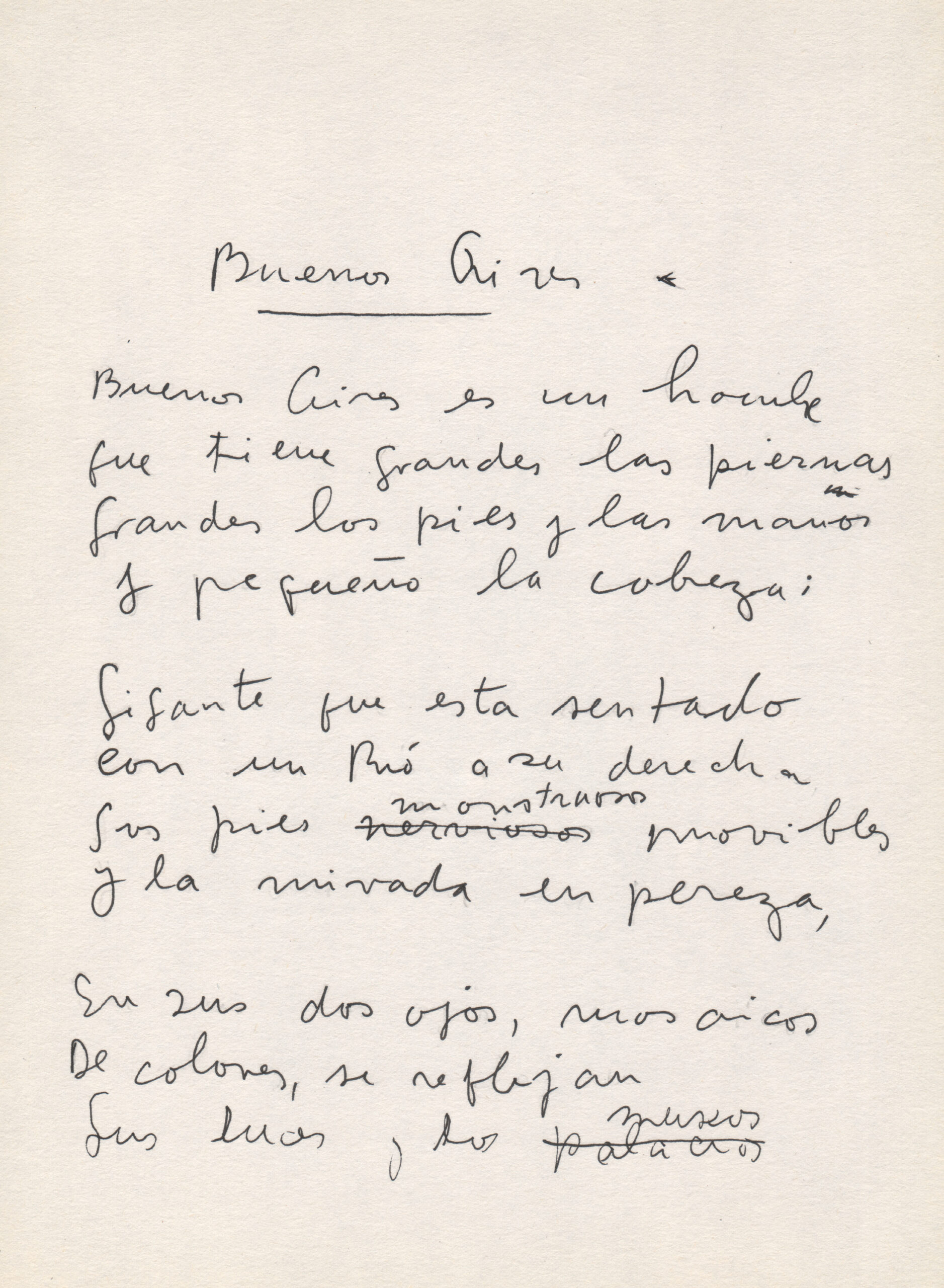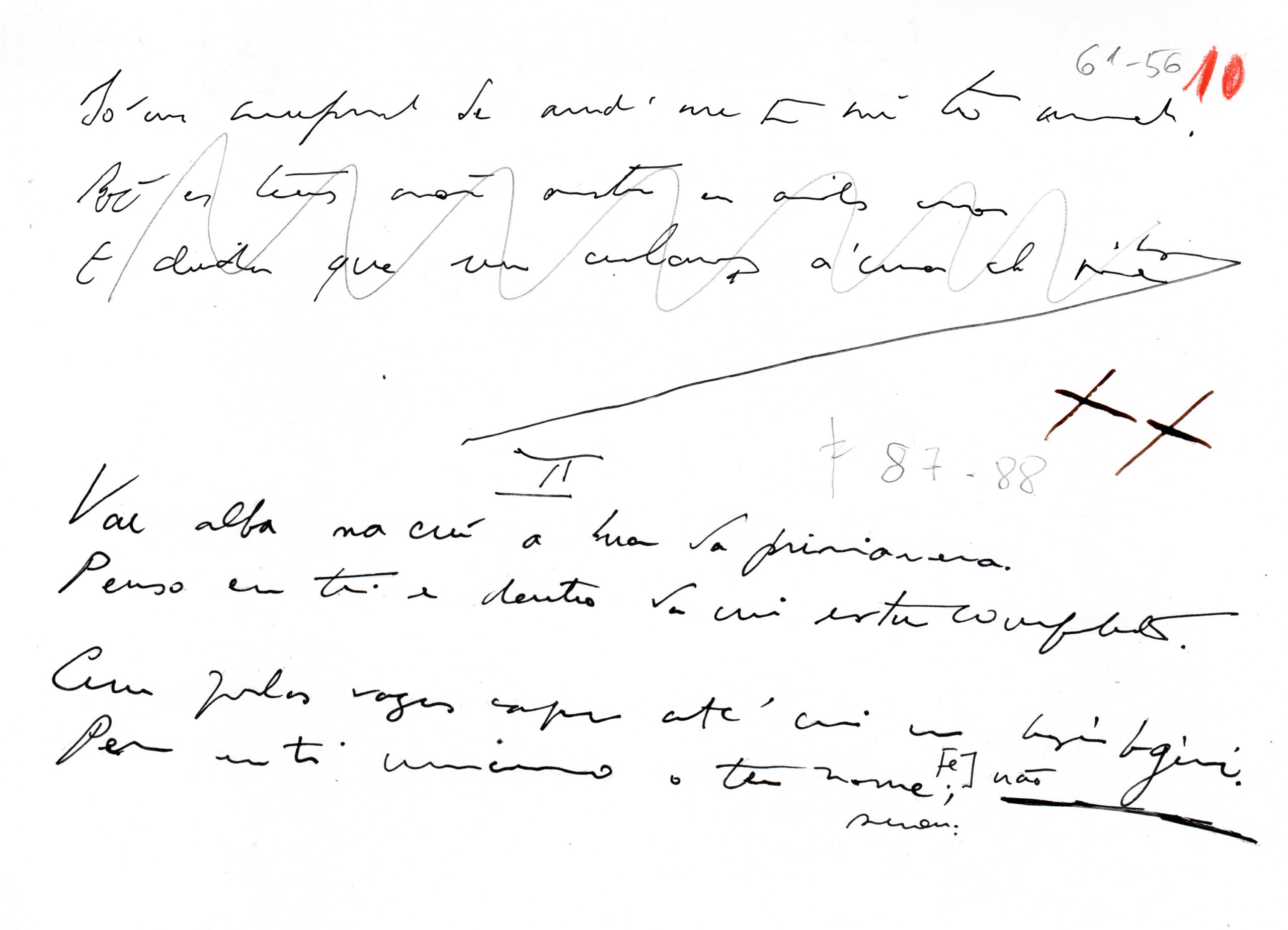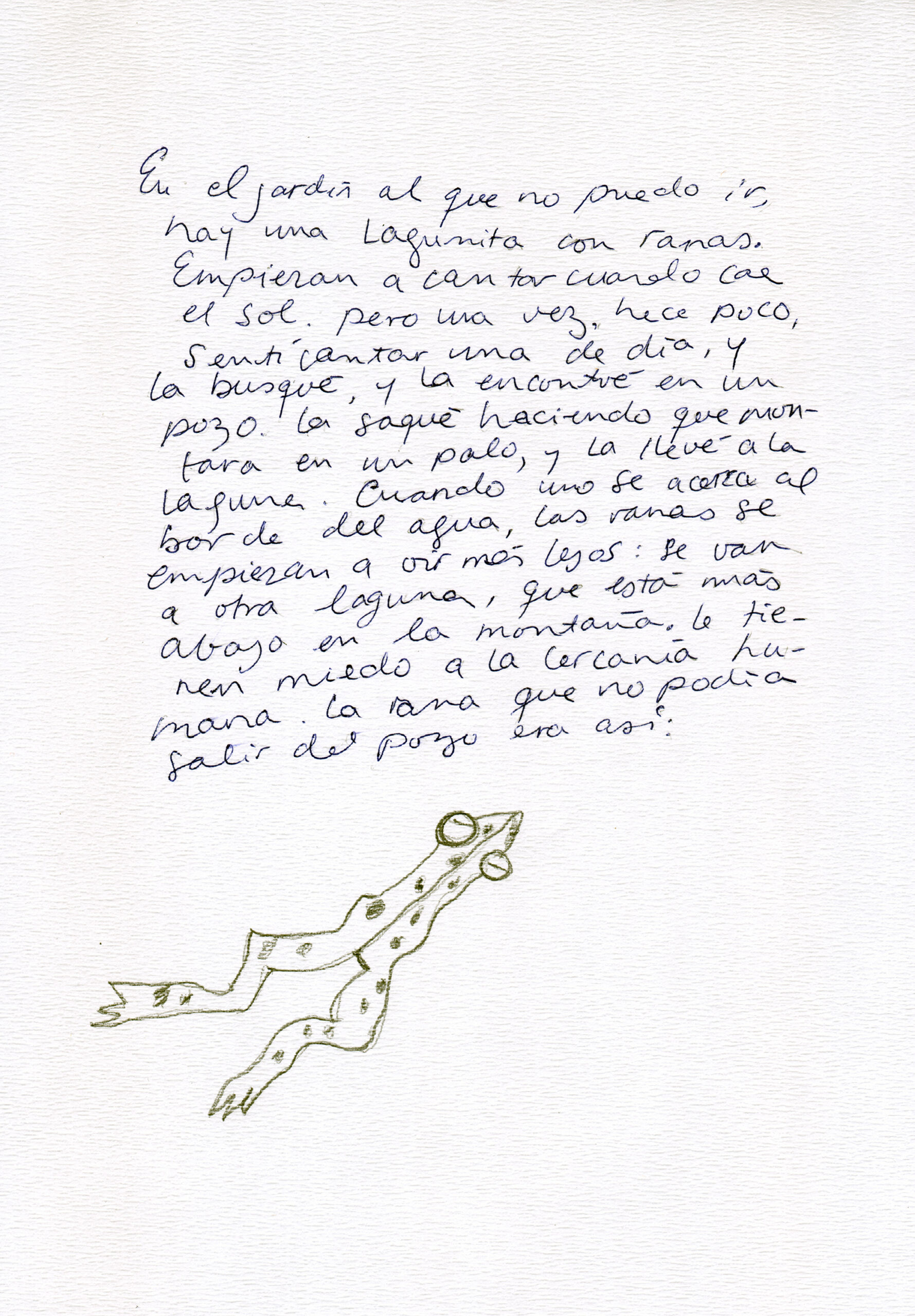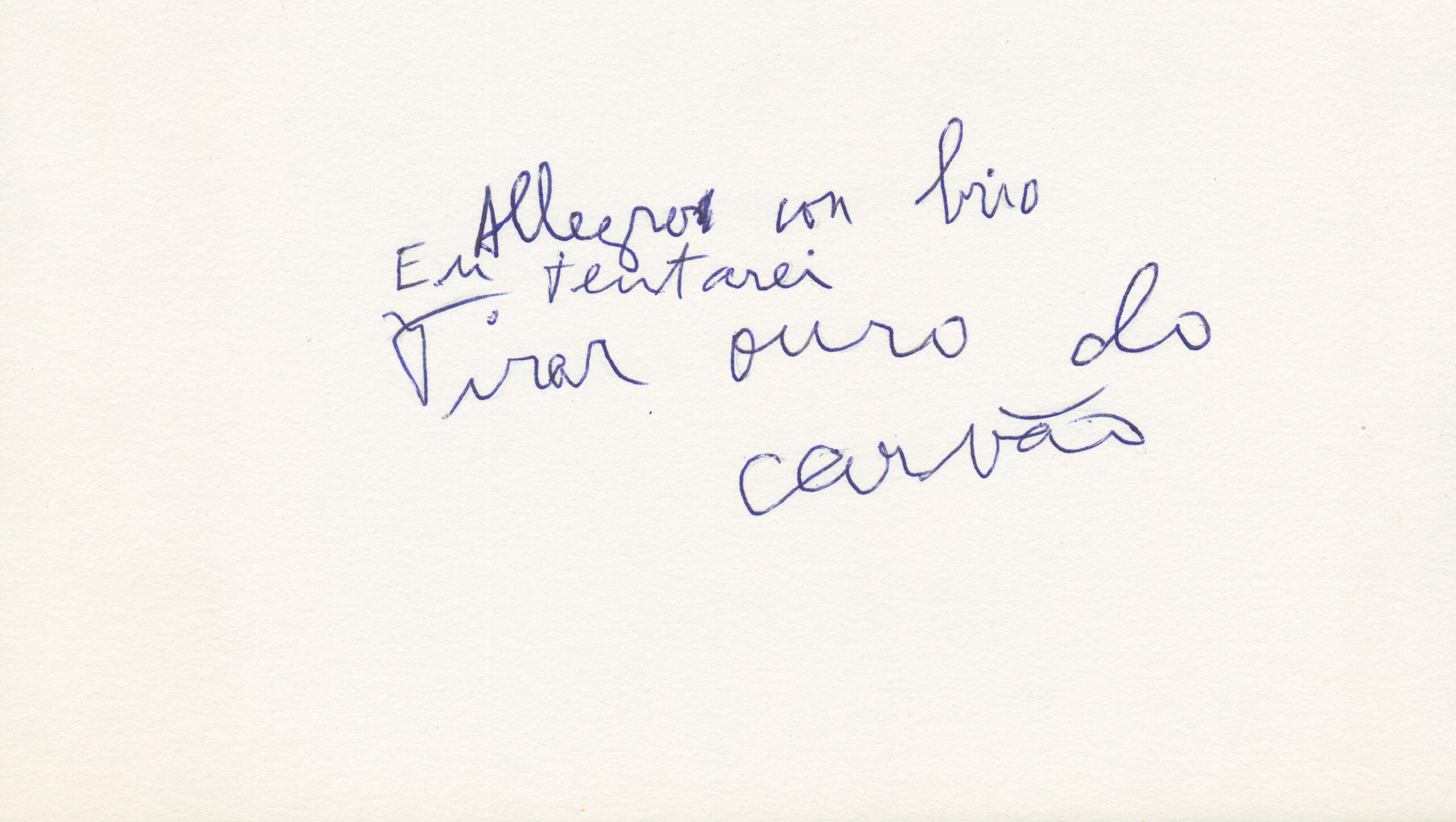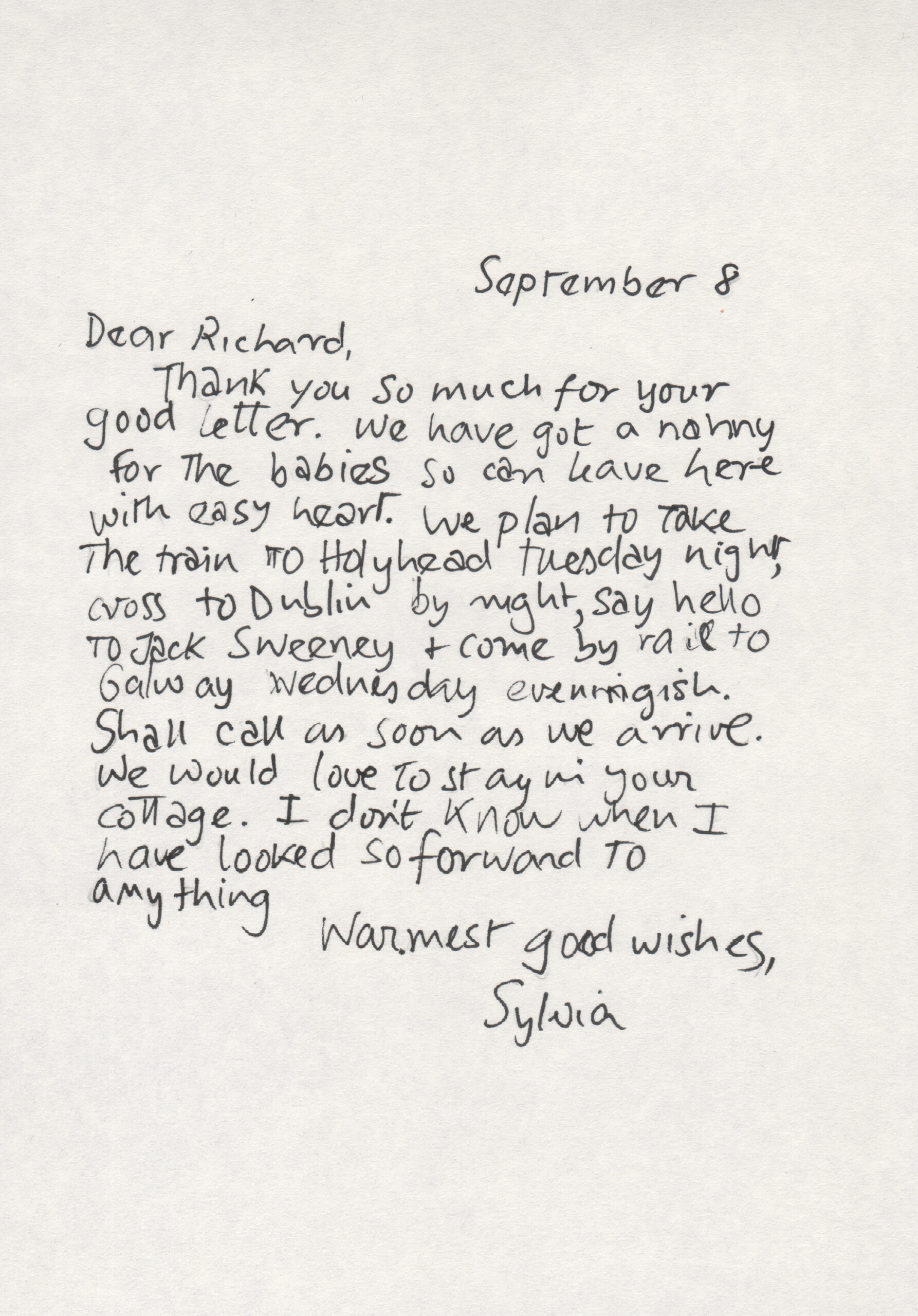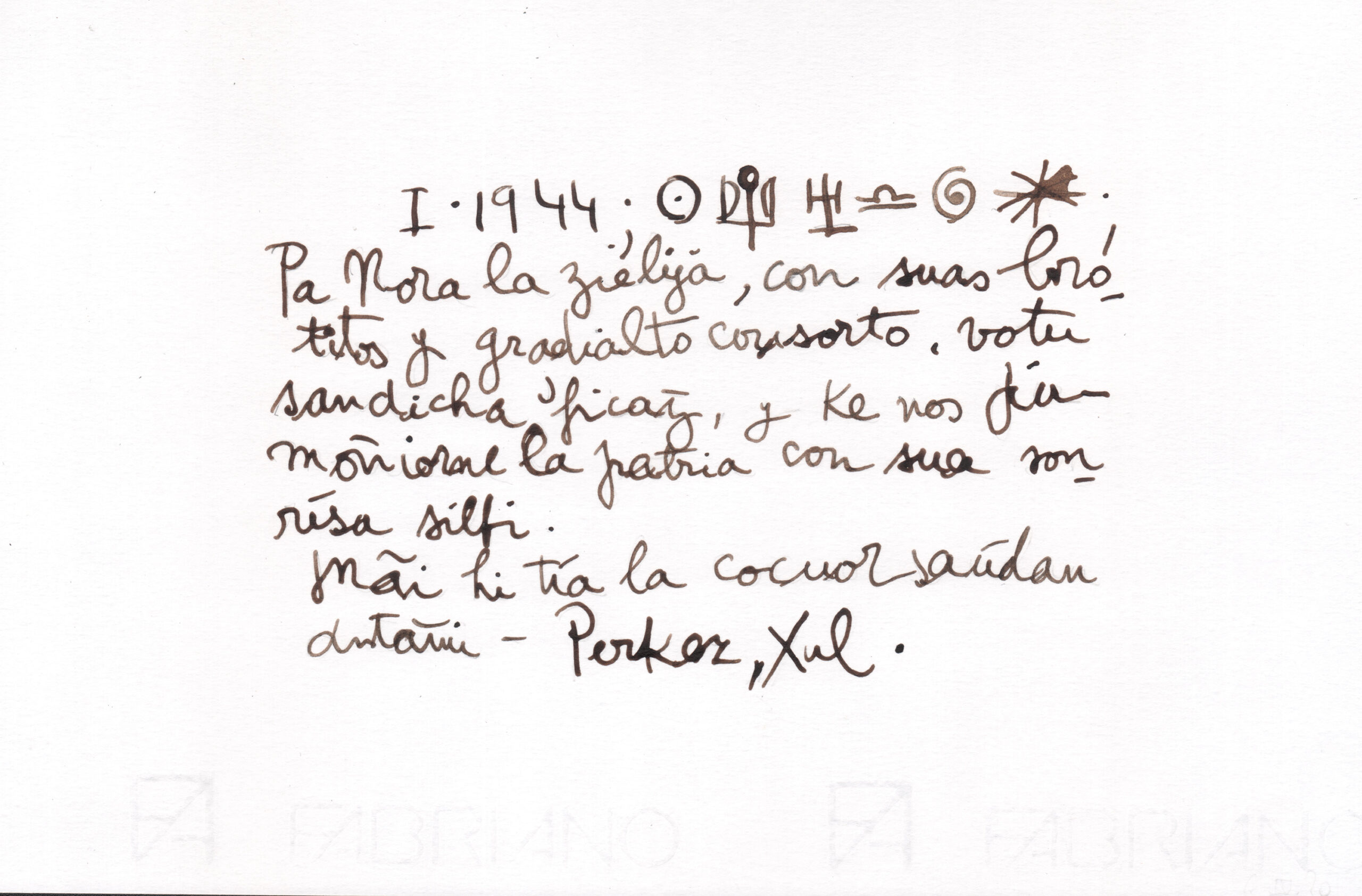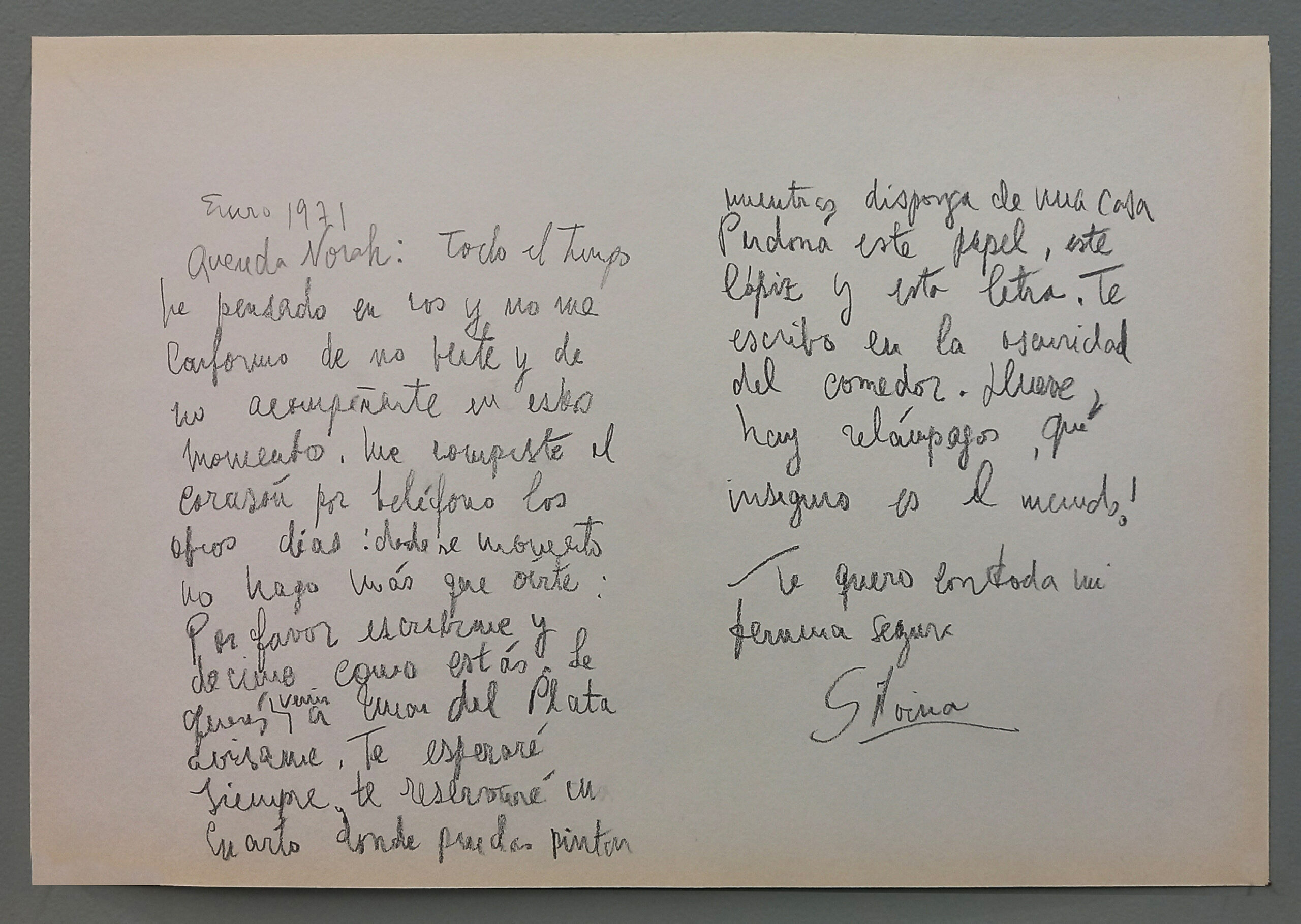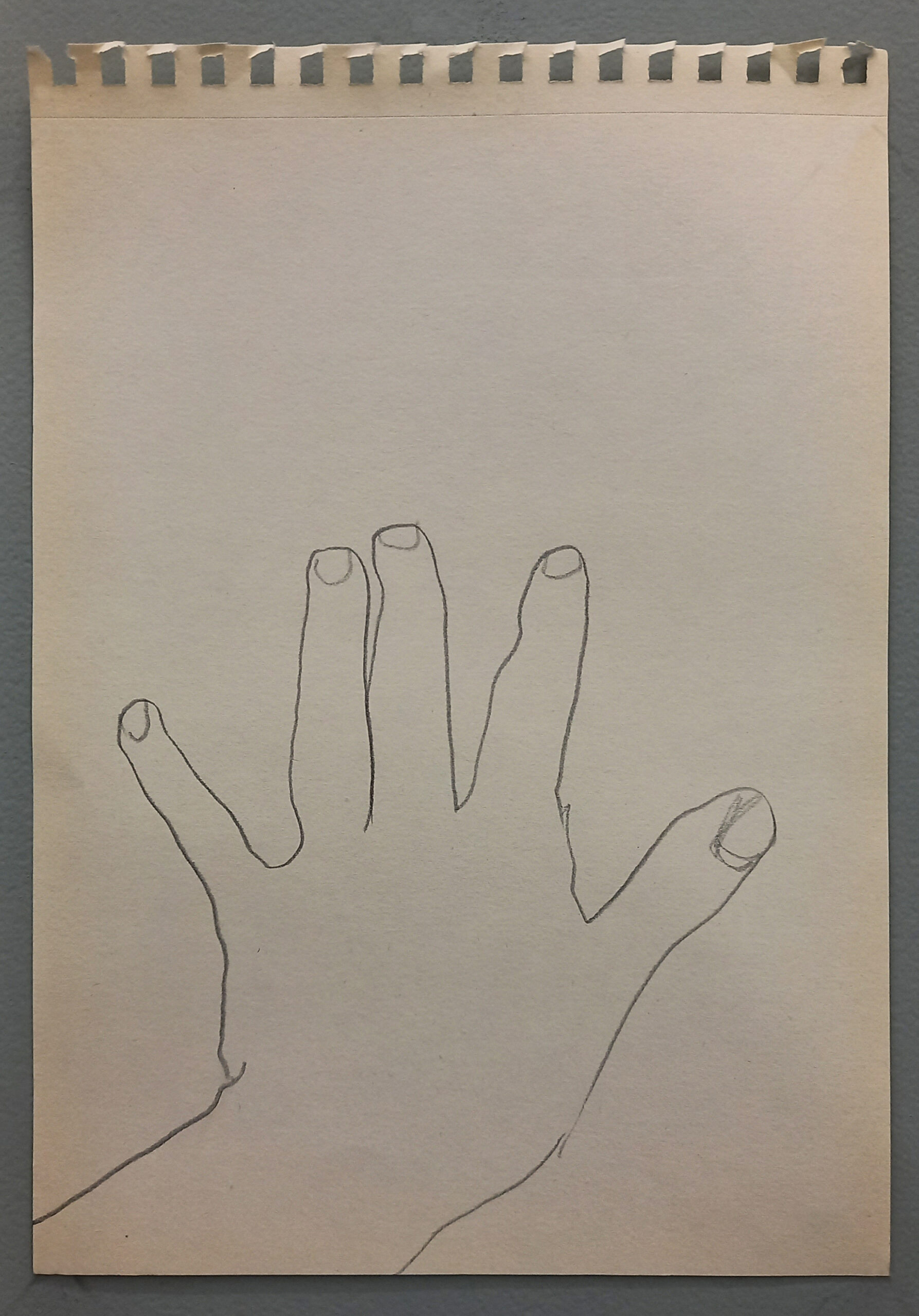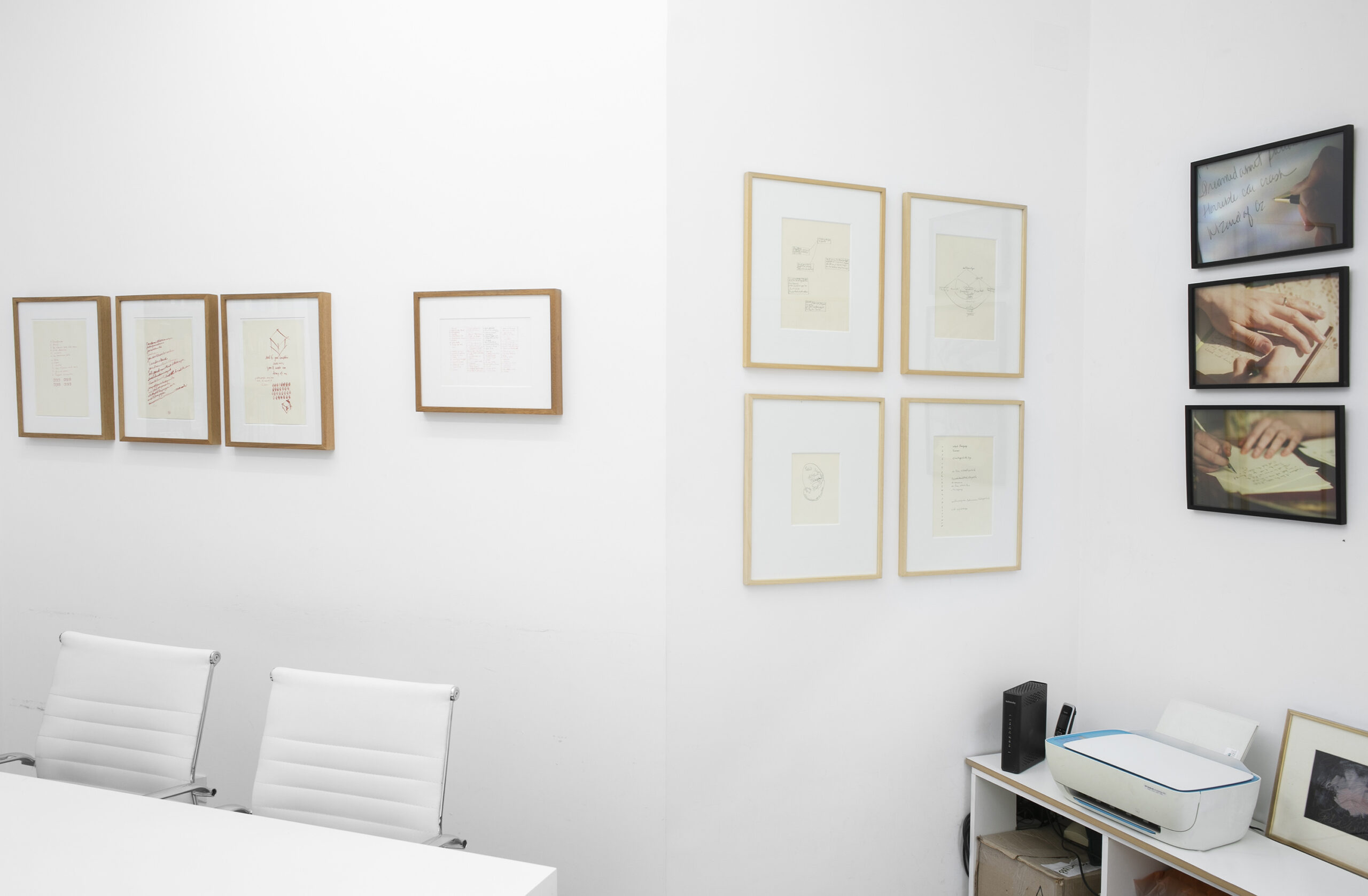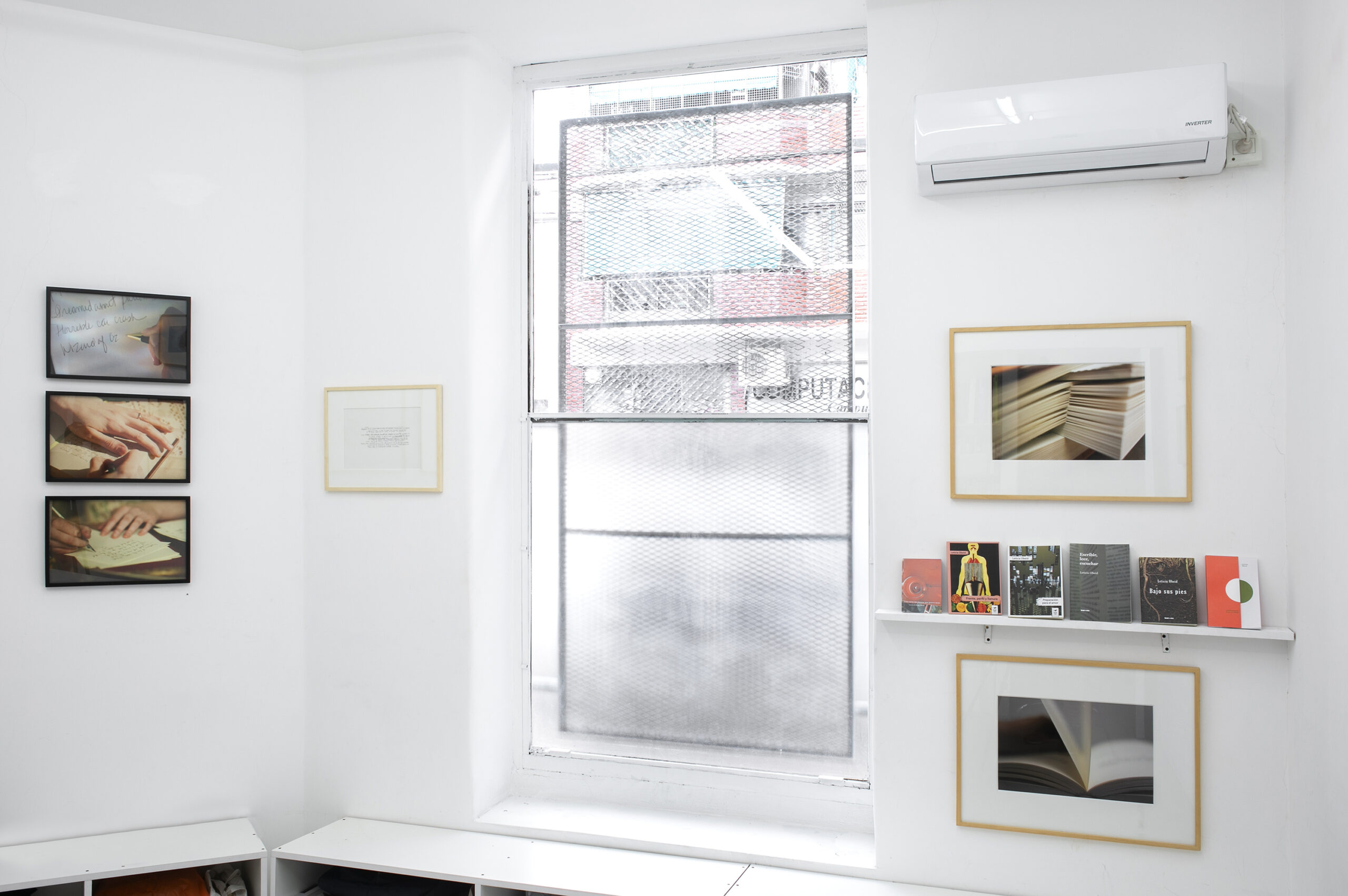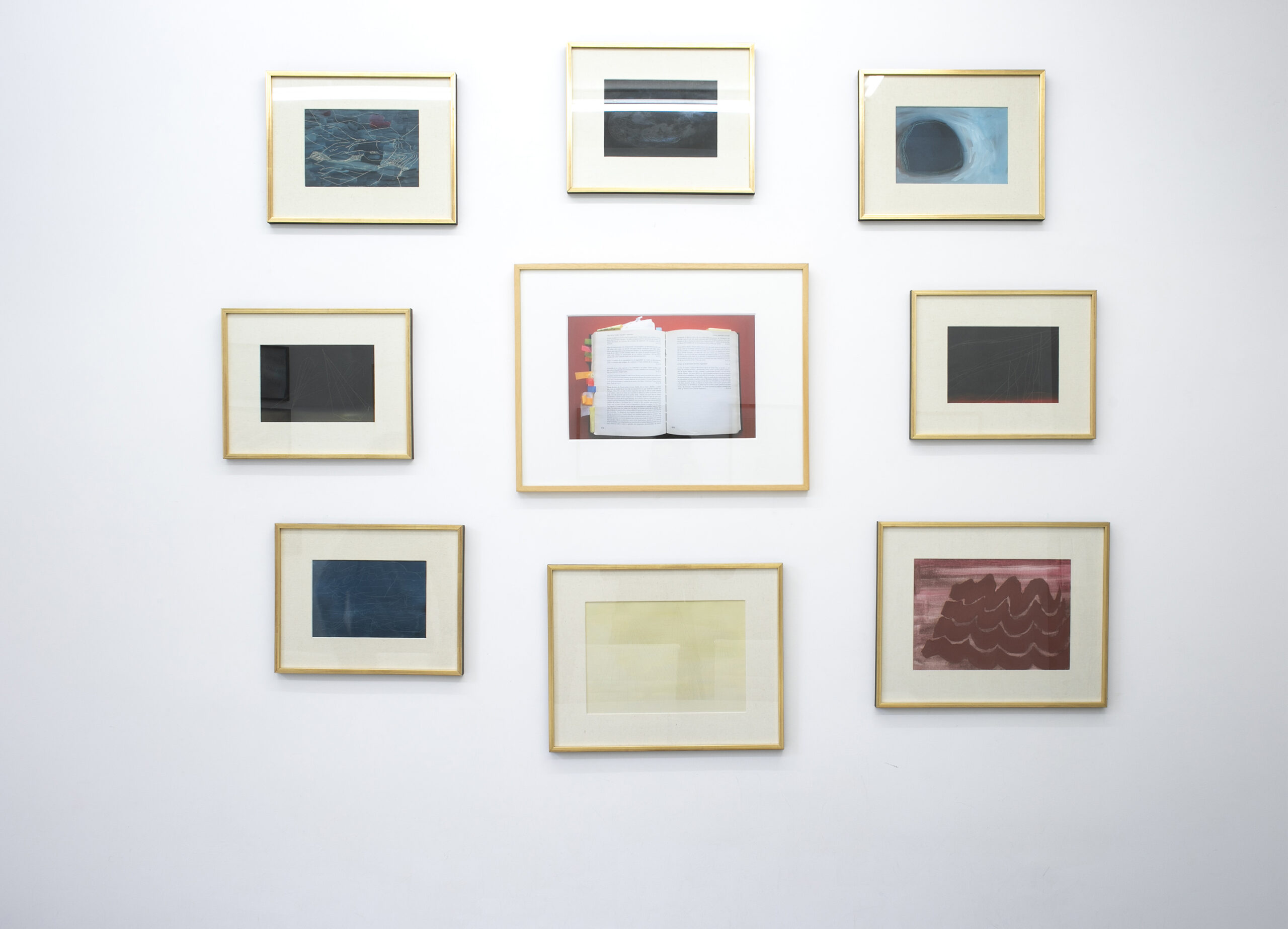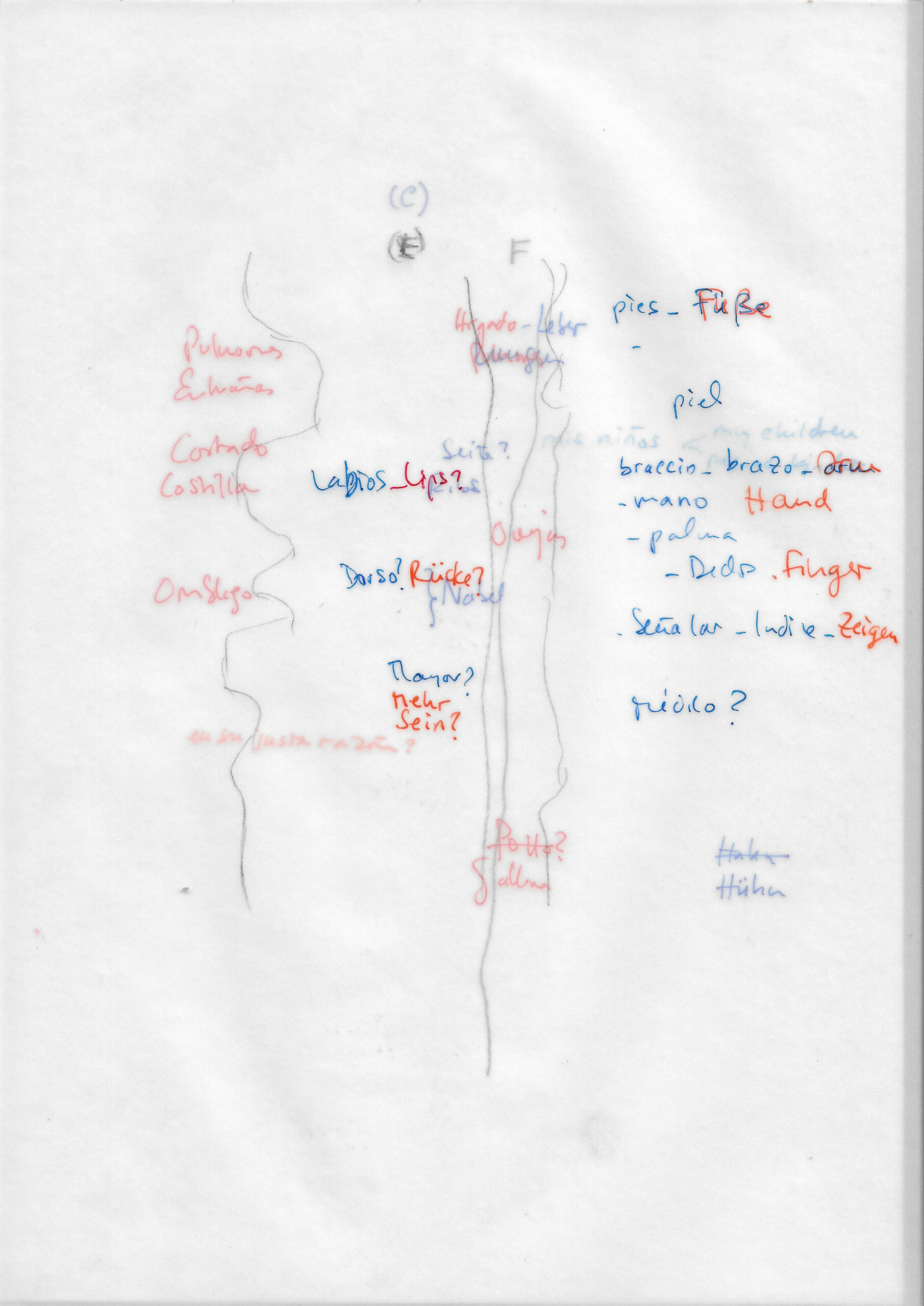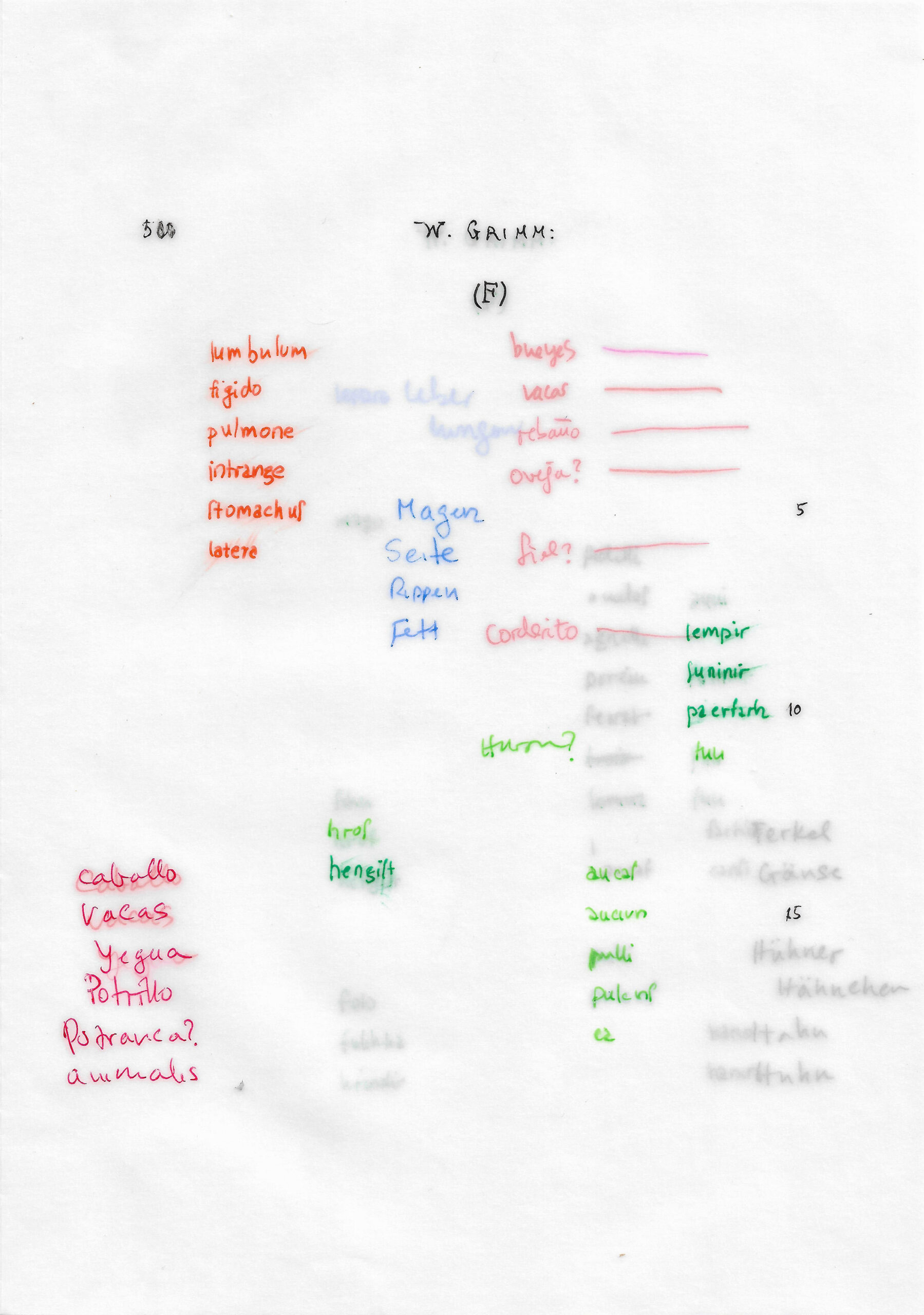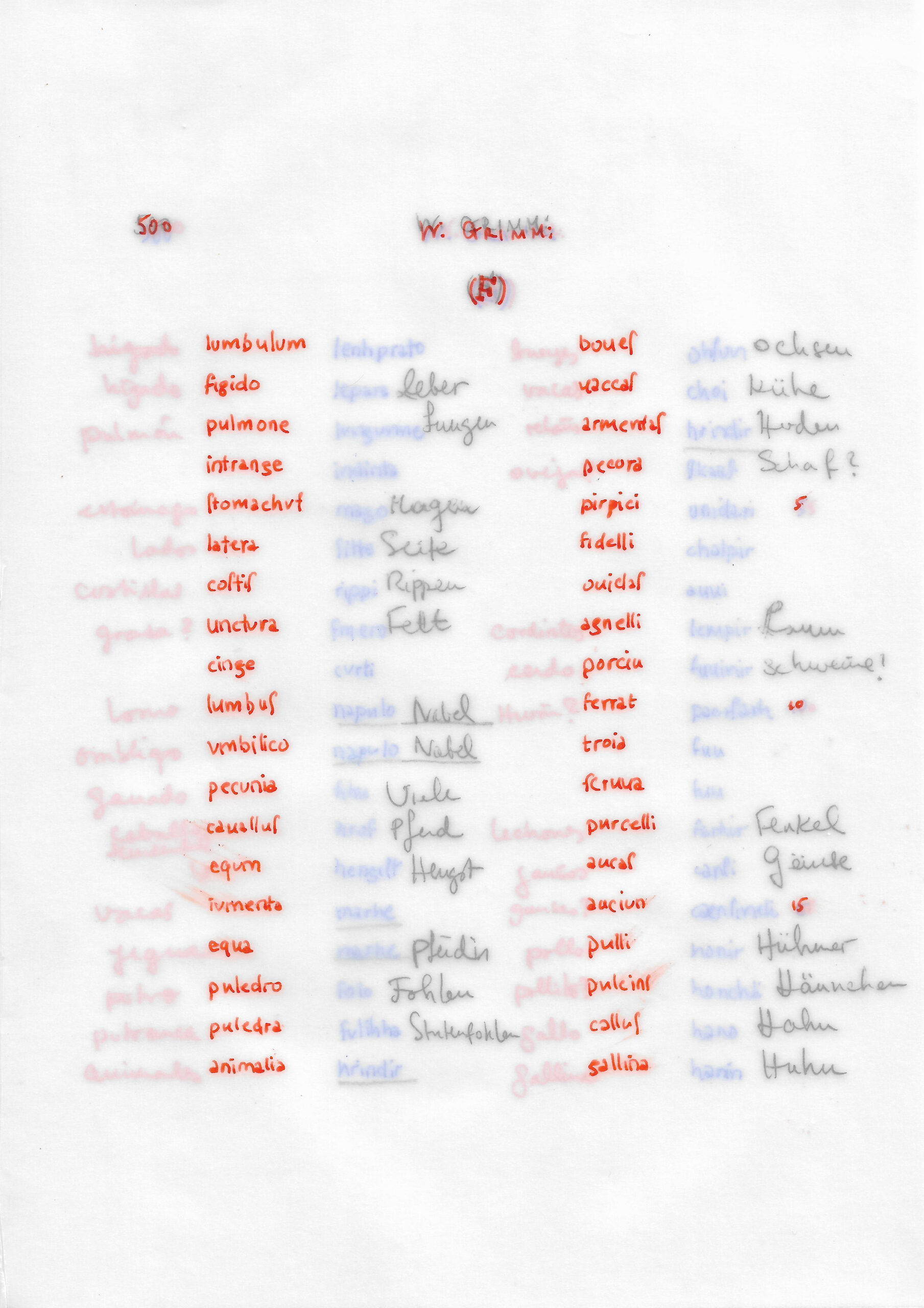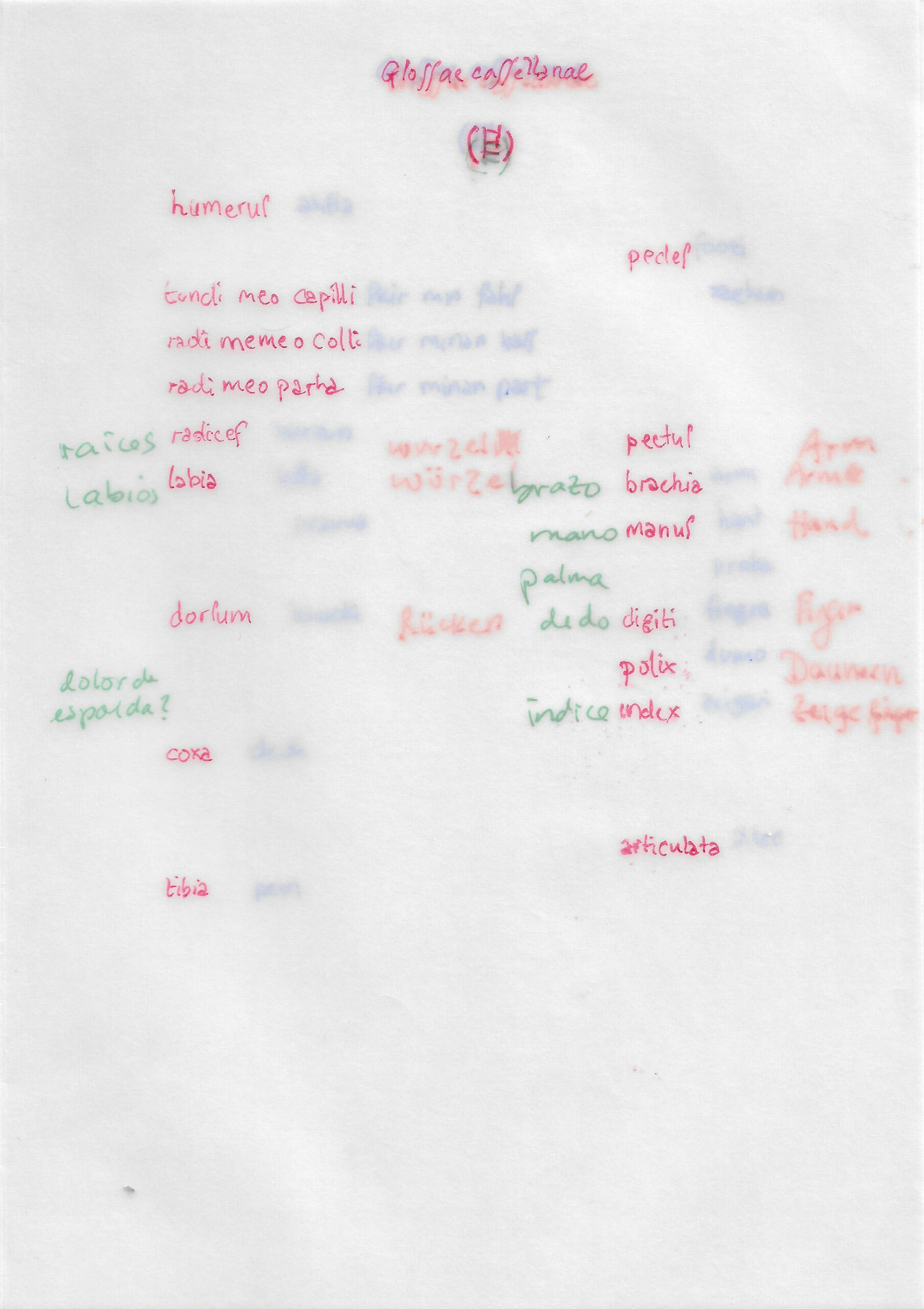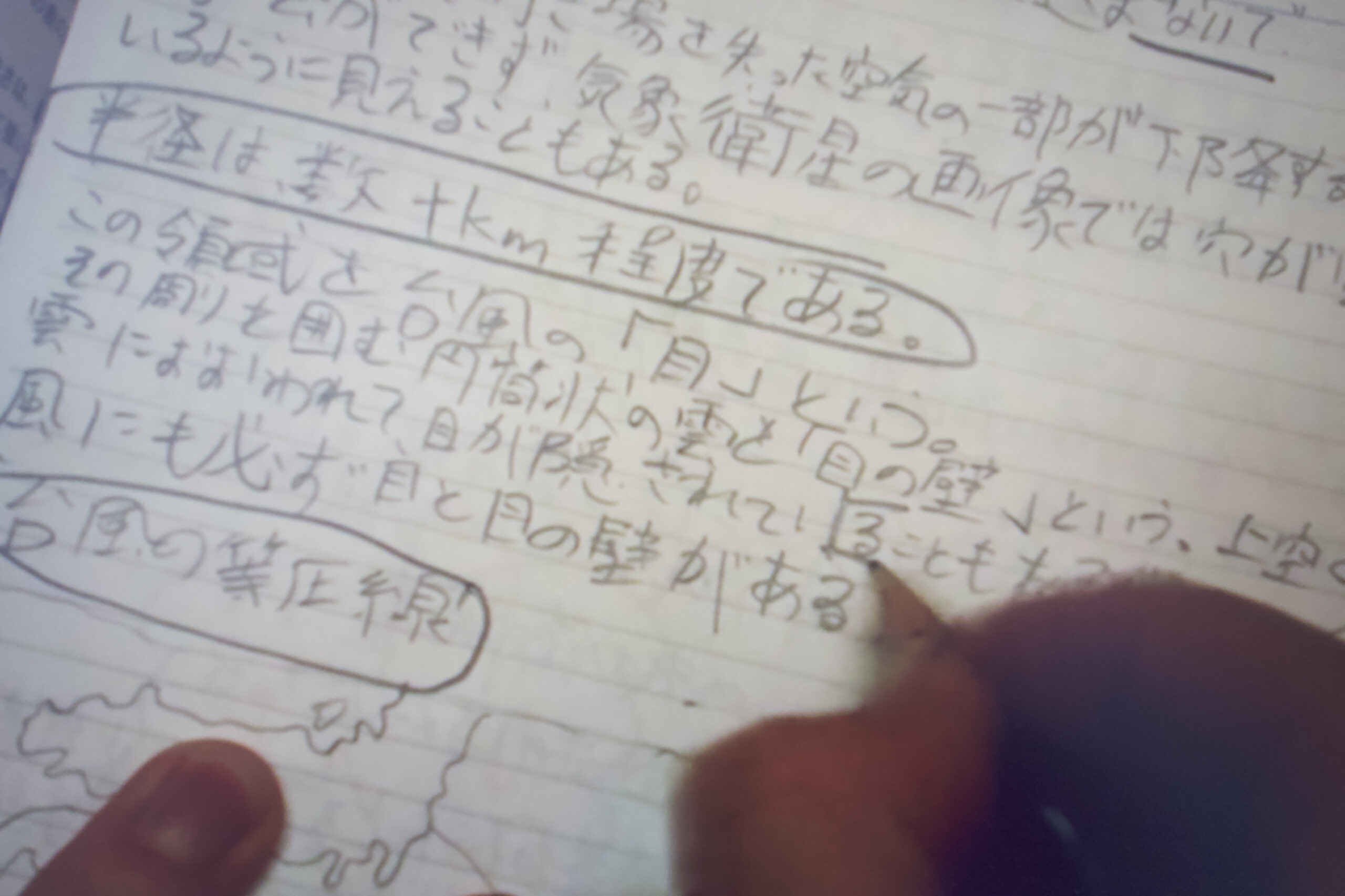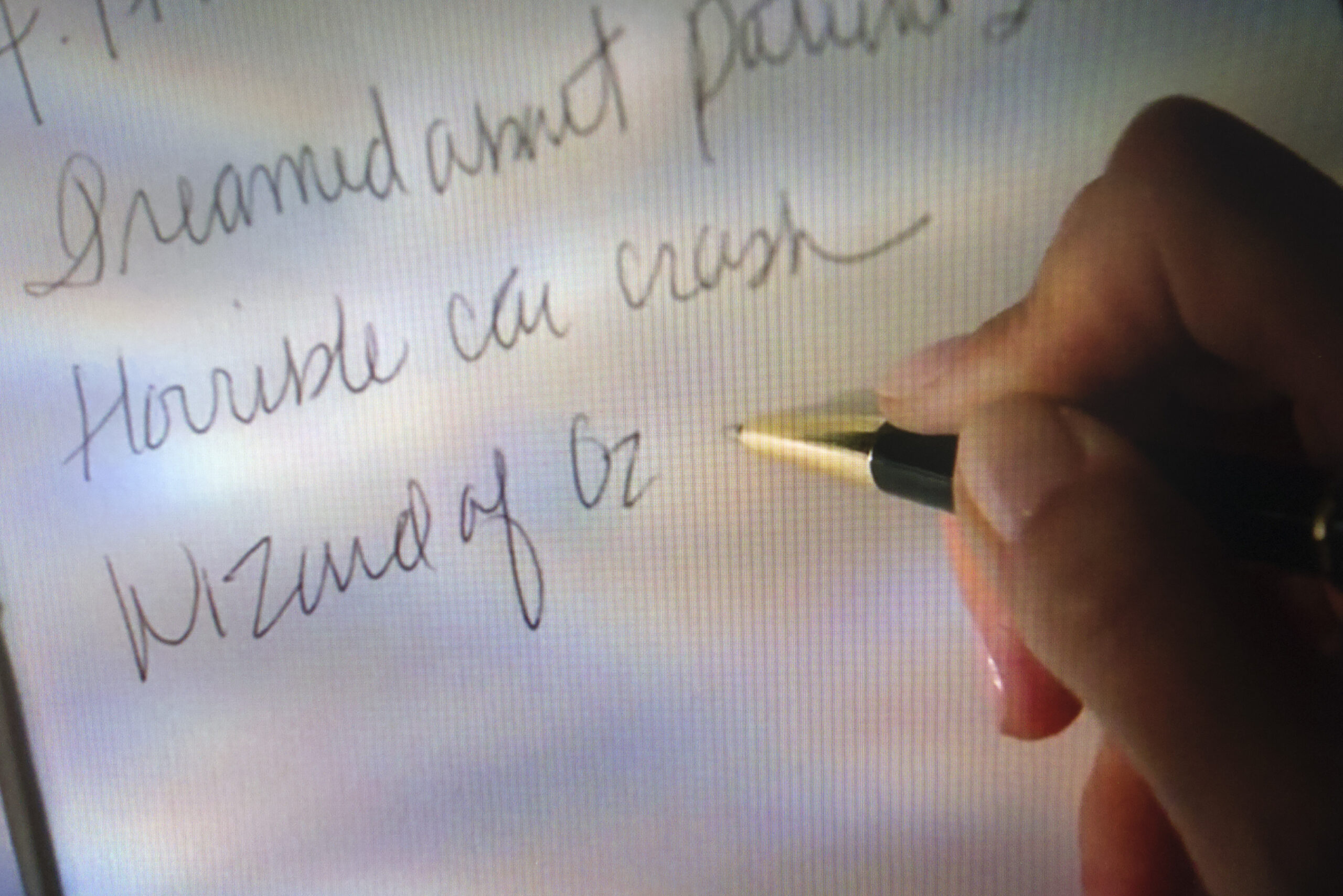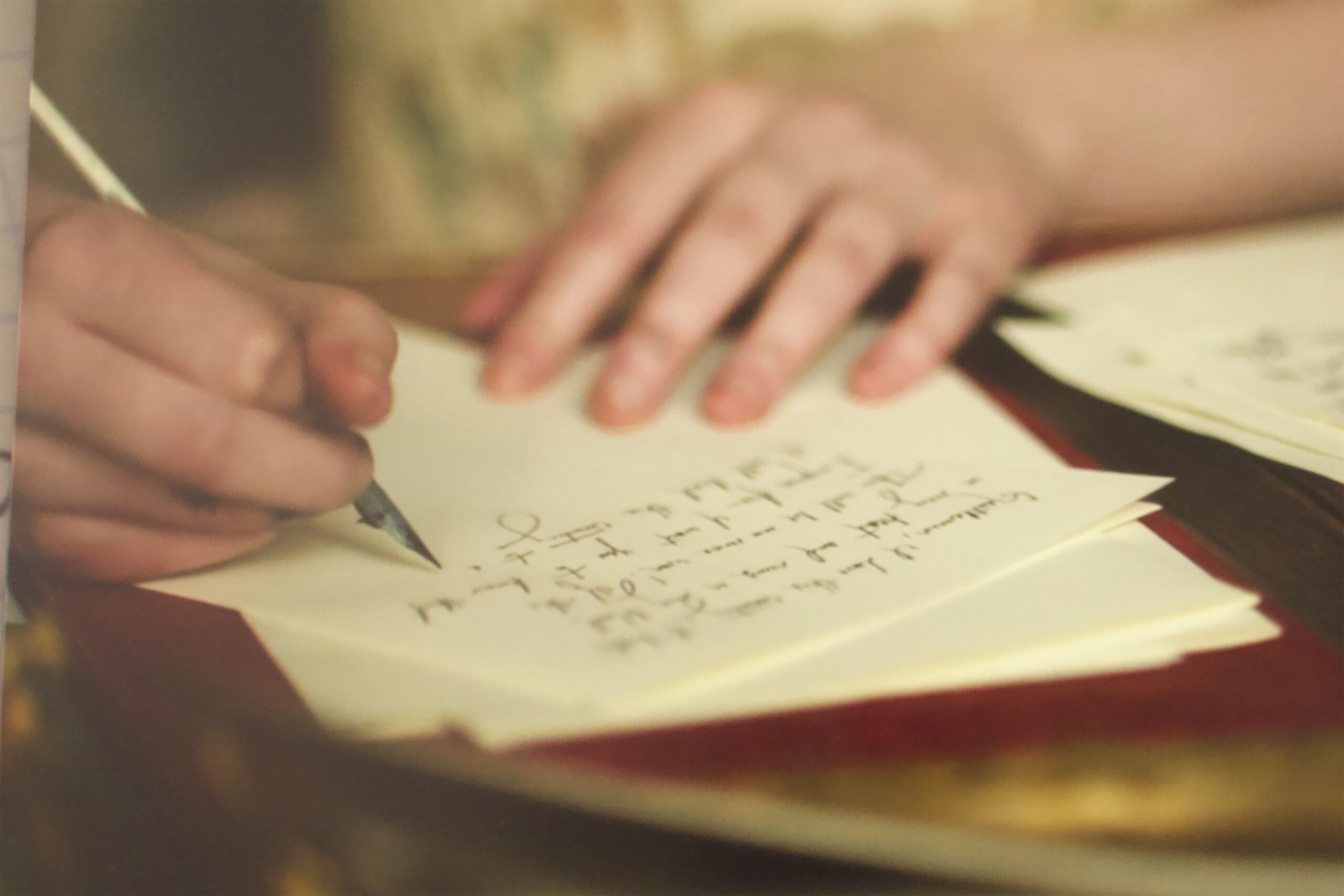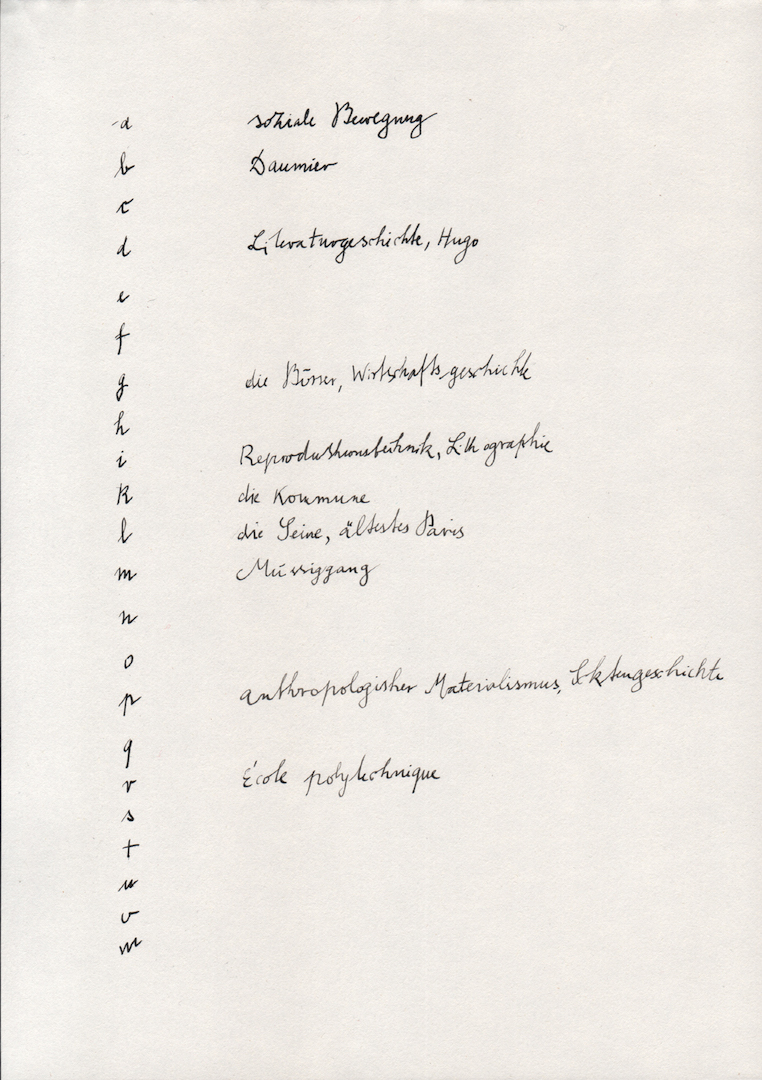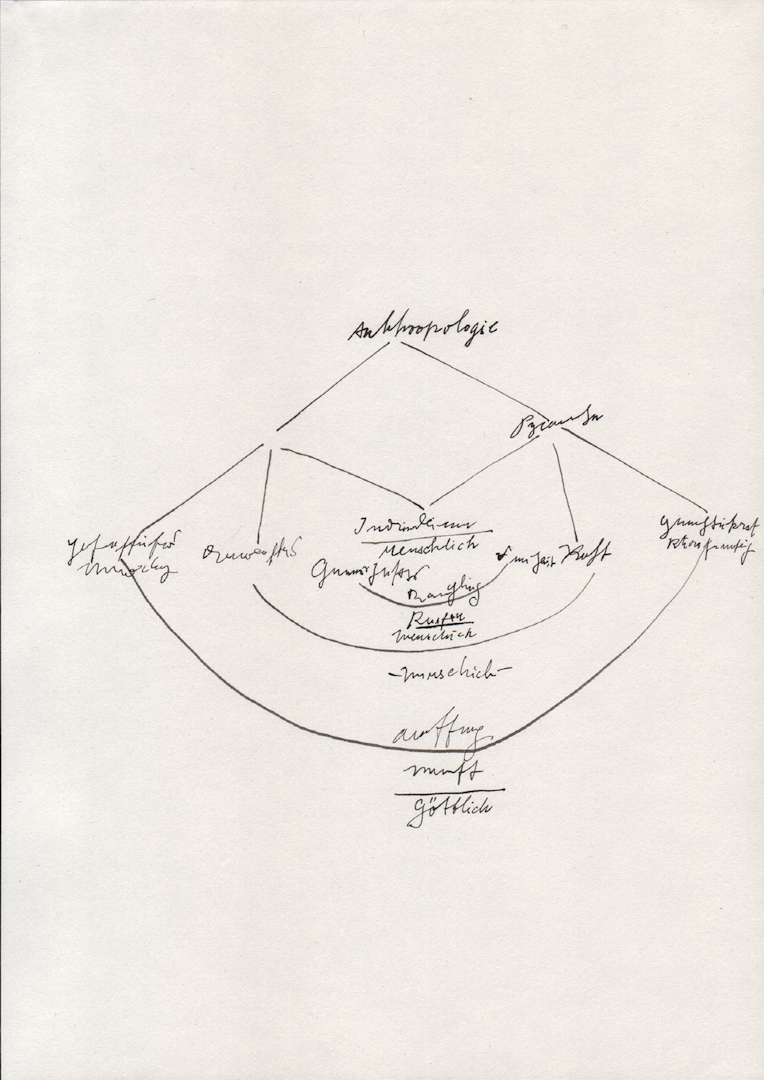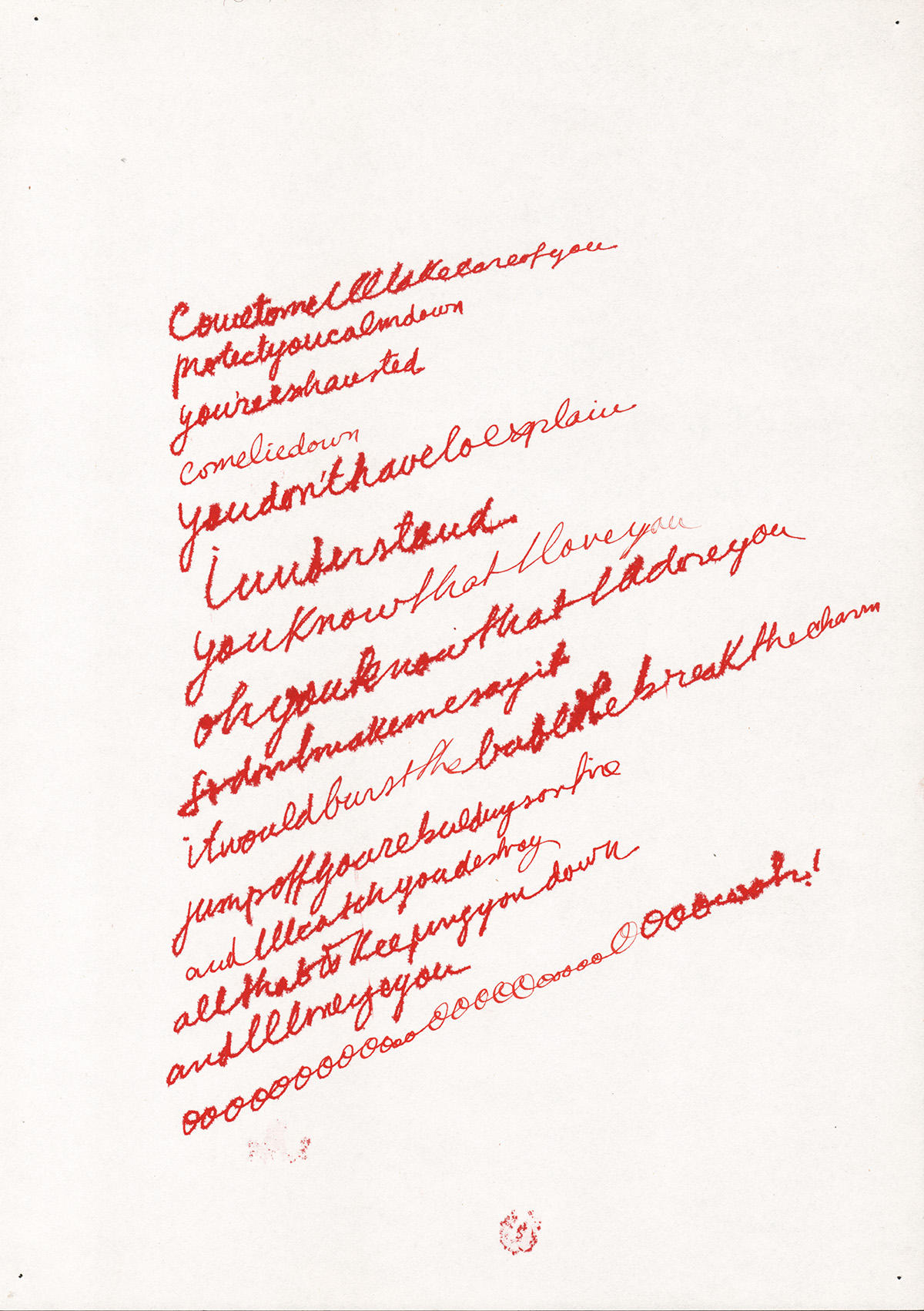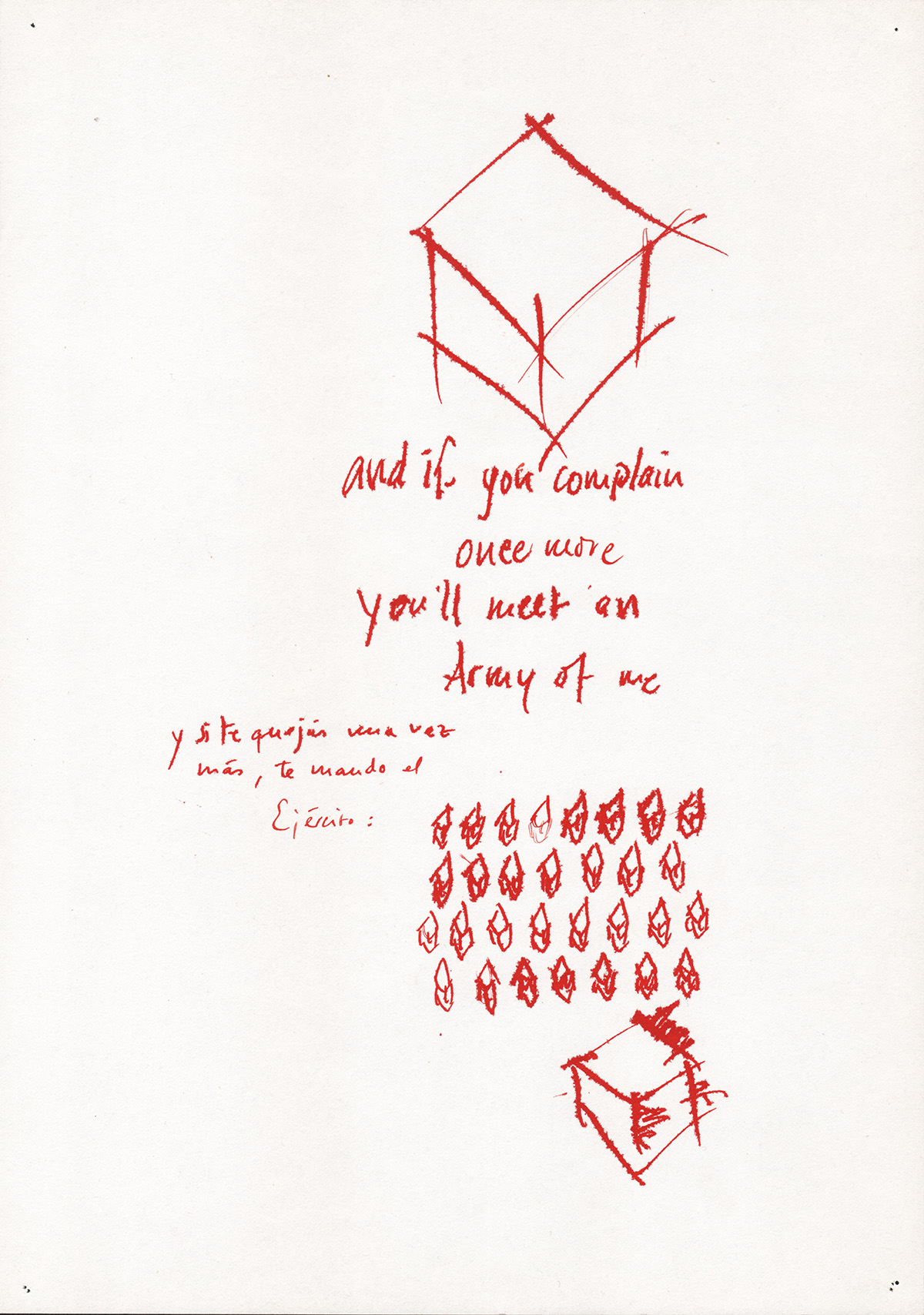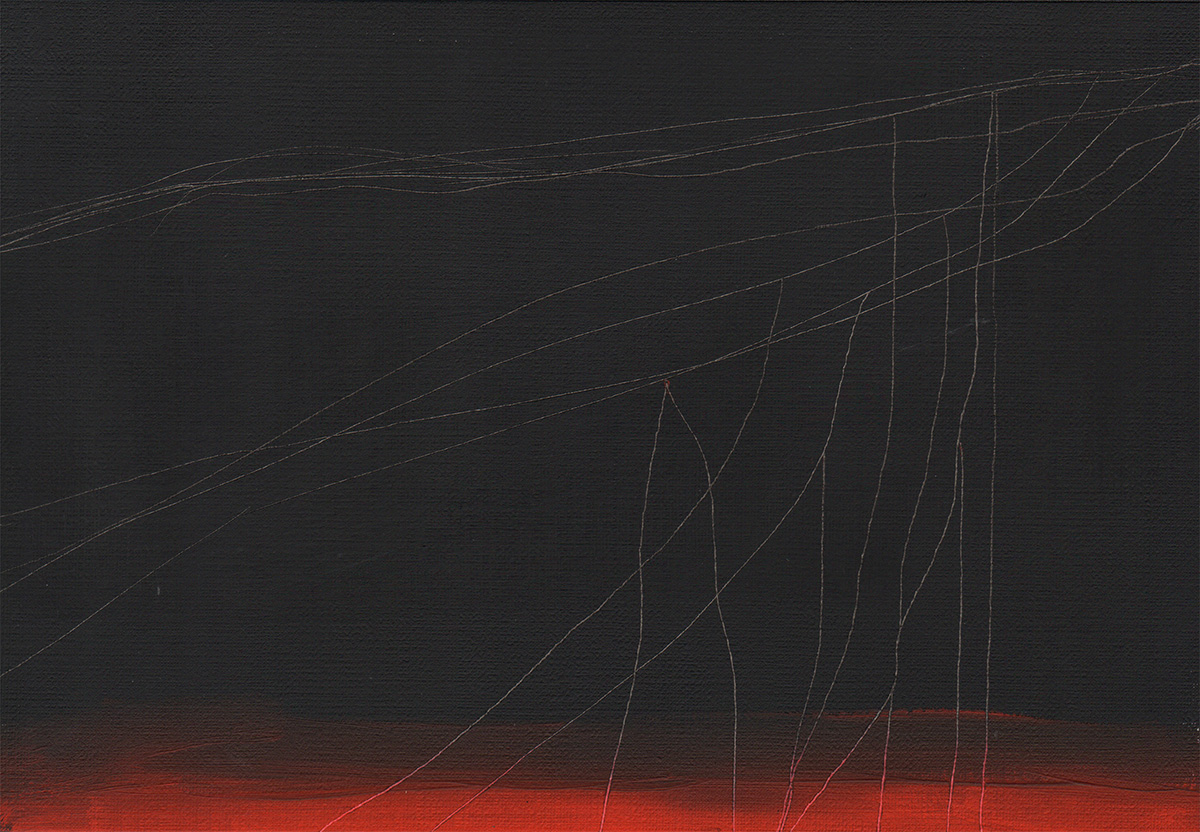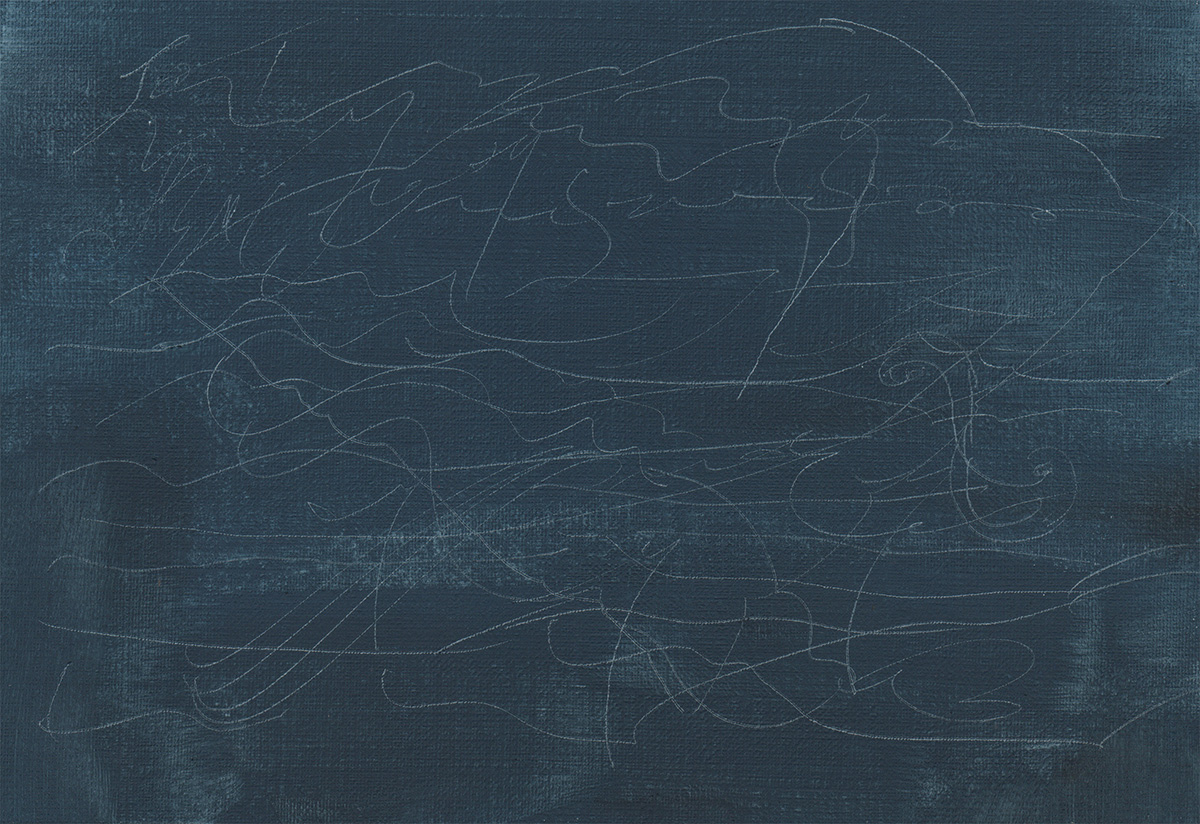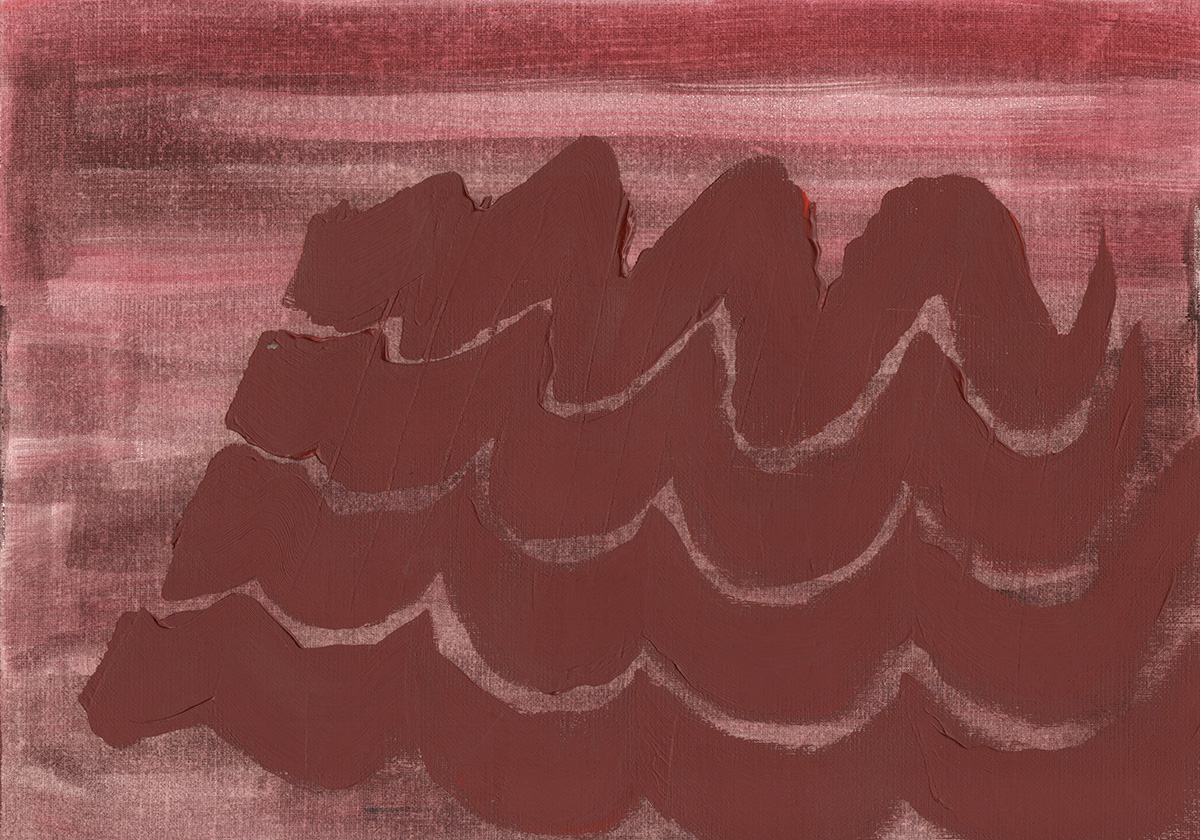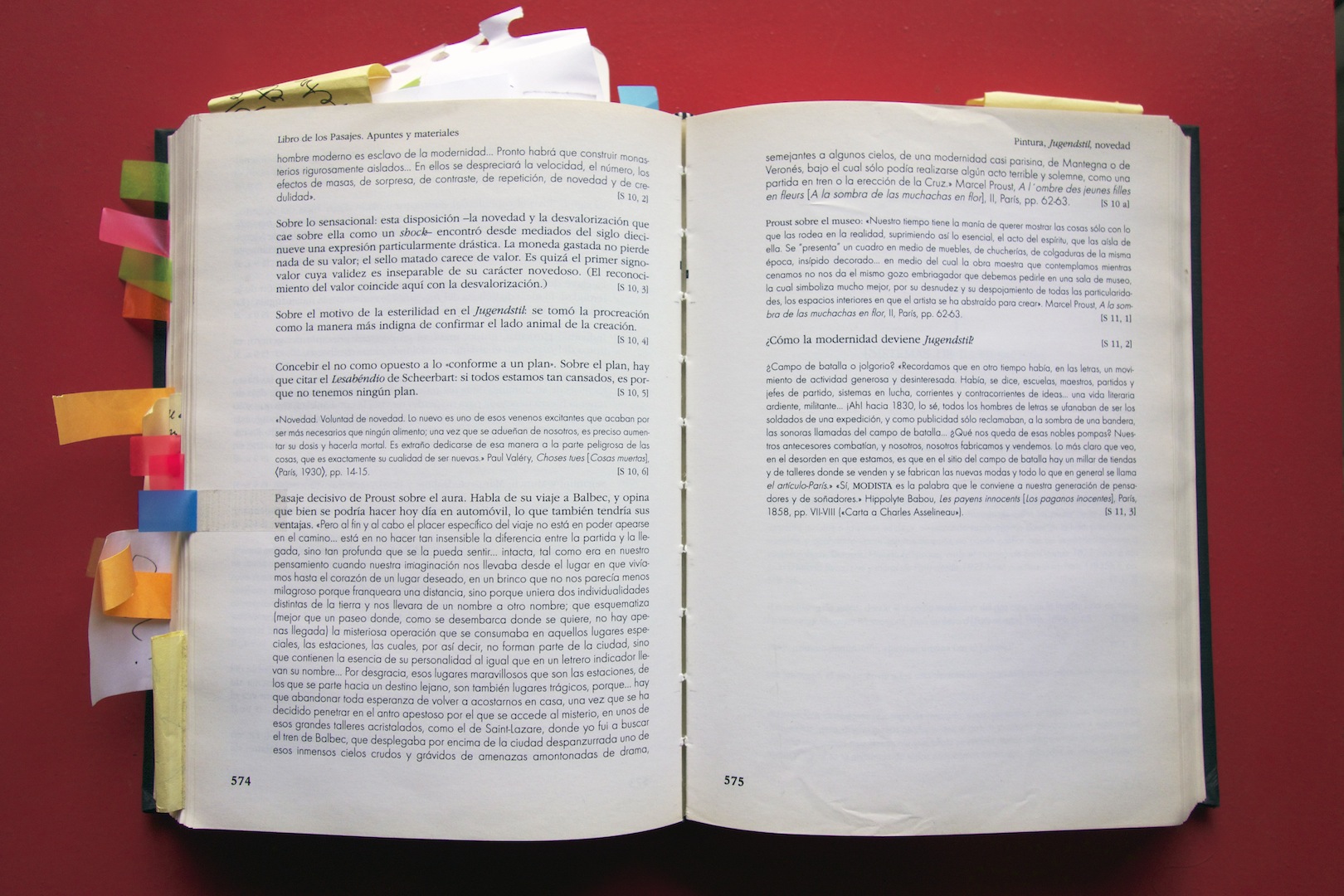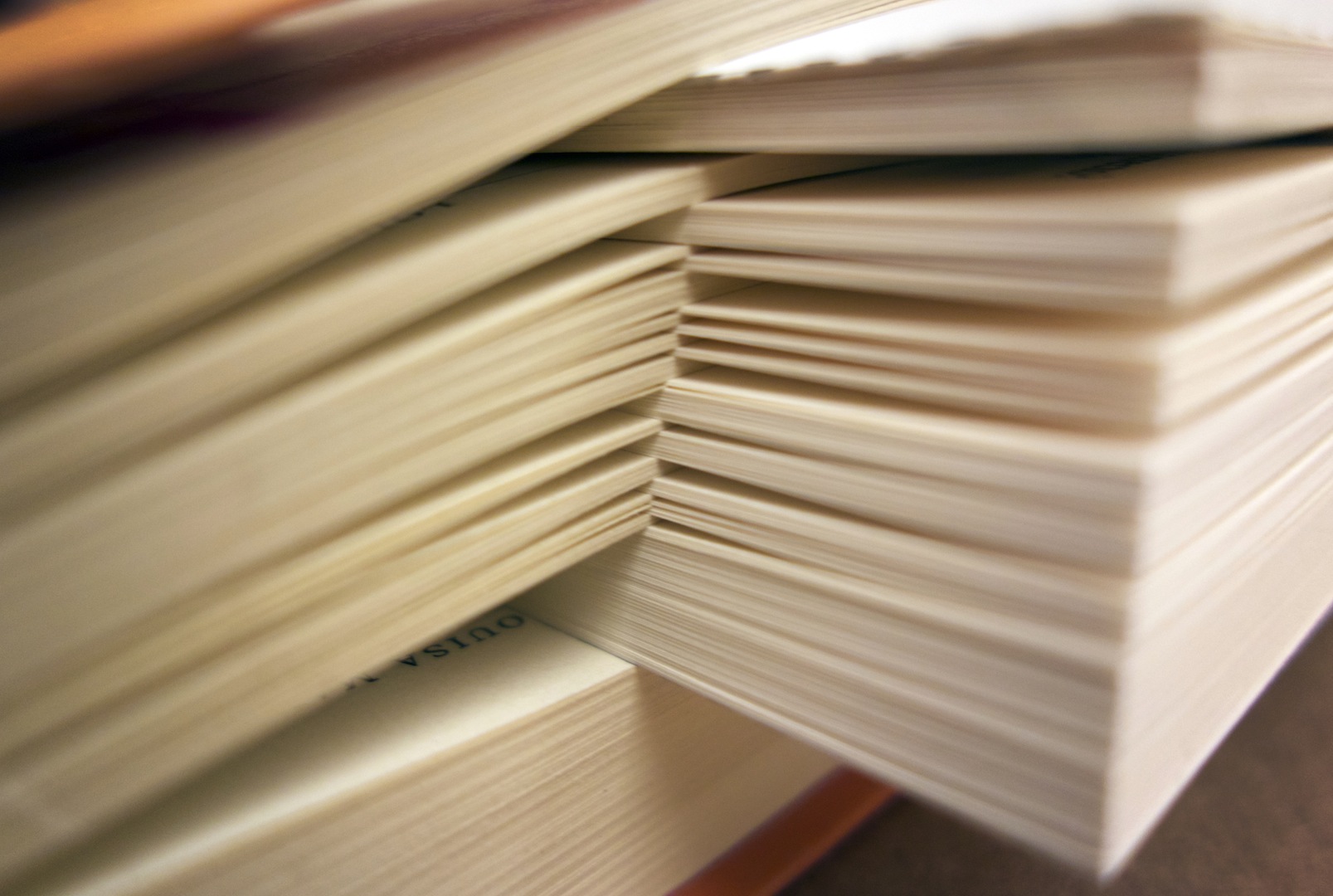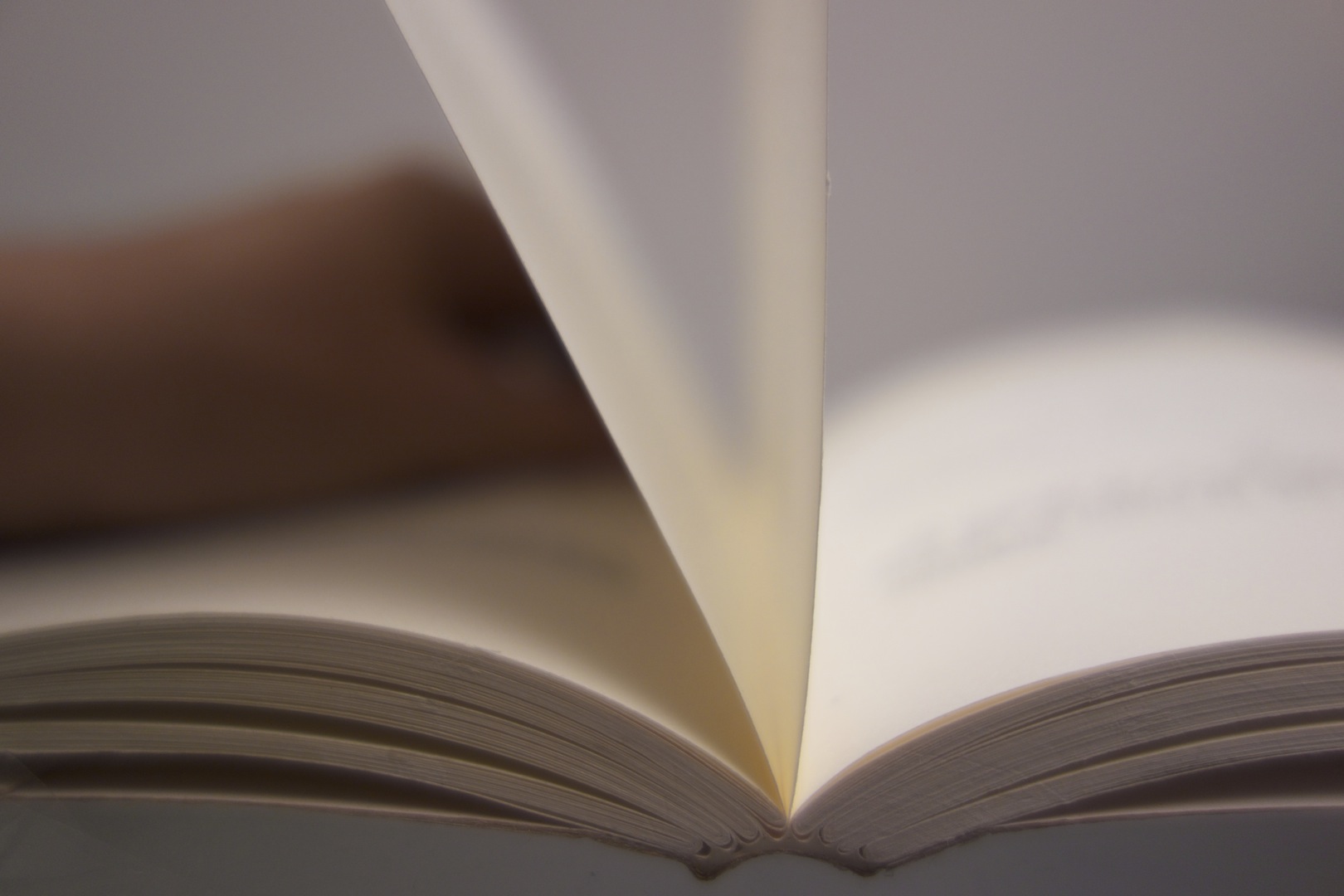Tocar el velo
leticia obeid
Curated by marcos krämer
nov 01. 2022 — mar 2023
Ph. Ignacio Iasparra
TEXT
LETICIA OBEID: TOUCH THE VEIL
a quick rustling, a vague breath of secret images
suddenly dull under the veil
with which loneliness defends it lands
Olga Orozco
A few months ago, at the height of the preparations for this exhibition, Leticia did a drawing on paper to show me how she felt the works she had produced in the last two years were interrelated. She drew five black diagonal lines askew to the center of the white sheet of paper; the lines met at a central point to form something like a star. What I saw, though, was the overhead image of intersecting paths that grazed each other ever so gently.
Tocar el velo homes in on and underscores two aspects nestled into the entire grammar of Leticia Obeid’s art, two beautifully uneven and imperfectly parallel lines that go from one end of her work to the other and that have appeared with more or less intensity over the past twenty-plus years of her production: contact and layer.
Layering is what Leticia has been doing since almost the start of her career as a visual artist. Beyond the manifest layering in projects like Fantasma [Ghost] and Dobles [Doubles] and in pieces like Vení [Come Here], that layering impulse makes itself felt in her love for video as artistic medium. What is video, after all, if not a concurrence of layered stimulations? In this show, video, though unexpectedly absent, is present in its parts: writing, sound, silent moving image, still image. Tocar el velo is, first and foremost, video language carved up, proof that to film is to layer sensory stimulation.
Leticia’s art from recent years has not, in fact, revolved around language and its crevices. It draws more on what surroundings writing and reading—from their materiality to their motivations—than on their epistemological outgrowths or on their abstract, graphic, and formal dimensions. I often think of her work as an examination of what Philippe Artieres calls “moments of writing,” that temporal sequence where, he explains, the objects, practices, and contextual circumstances of the written are enmeshed. Because, in Leticia’s work, writing (and reading) are unique performative acts, and her drawings, videos, and investigations are registers of them.
Tocar el velo dwells on those moments of writing. It embodies the graphic craze that leads to writing on a sheet of translucent paper the size of a person; it presents the bareness of the voice in its volatile literature; it creates a double of the letter of others by retracing with pen or hand the path drawn by other writers. That is why on exhibit here are different groups of works that both venture and underscore the idea that, when rendered image, writing and reading expand beyond the imagination they convey and share centerstage with what is near them: sheets of paper, inks, hands, voices—always layered and always in contact. Because if there is one thing that runs through Obeid’s production it is not writing or reading as actions but the presence of that which surrounds them in the most literal sense: palpable objects—essential agents in the vicinity of the sheet of paper—and her hands picking them up. And that because writing and reading are unquestionably ways of arranging sensations, turning them into ideas and blind
images. But they are also—and fundamentally—practices to feel our way toward each other, to almost touch others with our hands. And that is what Leticia Obeid’s art does.
For some of the works on exhibit here, the artist turned vegetable paper into a vellum, a thin veil that enabled her to put her body on top of what attracts her, like a seamstress with back bent over pieces of fabric. She used a computer screen as a light box and traced manuscripts found on the internet and notes written out longhand in a text by Cesar Aira. Between the originals, stacked in bookcases or salvaged from friends’ crates, and the papers we see here lies manual layering of different materials and times that span regions, neighborhoods, and digital filters. This is, without a doubt, an exhibition of approaches, of drawing closer. What is brought to us in the large pieces that open the show, for instance, are handwritten notes by authors from other times, intimate writings like letters, diaries, or rough drafts that bear the sentimental outburst of their non-literary quality; those works mingle with passages from the artist’s old journals and notes. Through the paper veil, Leticia brings to us intimacies that would never have surfaced otherwise.
For the first time, she assembles a constellation of writings and joins the light of her own star to the light of the stars of the authors she admires, the ones with whom she feels a sense of kinship. And therein lies the novelty, or part of it, at play in these works. The veil that overrides the temporal and physical distances between the artist and those writers constructs an imagined community, an uneven chorus of voices. A chosen family, a desired family surfaces—head-on, as with any wall, but also fragile and at the mercy of the wind—as the materiality of writing.
Layering is, in Tocar el velo, not only a technical procedure but also a way to underscore the romance between Obeid and the written word and language. Layering through a veil is a way to imbue a beautifully heartfelt image in the difficulties intrinsic to communication even when those difficulties are not entirely evident. It also rests on the certainty that intimacies open up through contact—hence the two-faced, even cruel, nature of any approach, of any drawing closer, whether between persons or between objects from different times. And that is where tracing as methodology becomes more patent, where the action of layering two of more surfaces and trying to keep under the hand writings that love one another from afar more visible. For Leticia, layering means joining graciously. It means finding the zone of contact between distinct elements at a distance from each other in time or space to see them at the same time as their double appears. The works here neither put up a veil to block our vision nor draw back that veil to haughtily reveal what is hidden. In the act of layering, Leticia palpates the veils there are between letters and us, between sounds and us, between images and us, to make them transparent and, in so doing, draw together times, materials, and lonelinesses without foreclosing any autonomy.
That distance is the one she tries to bridge in the photographs of her hands resting on the screen. She seems to be reading the image frozen on the screen with her hand, as if for her to look were the same as to touch. In these photos, Obeid is testing out the distance—or the closeness—between her body and the images, trying to shorten it, using her hand, the same tool used to write. A soft hand barely alighted on the still images, trying to ease the twisted hand that always assumes complex, almost unnatural positions. The artist’s gesture eases the tension in longhand writing. It is a gesture that seems to put on hold the moving image to get a sense of its impossible temperature and to caress the physical tension in the act of writing. At stake in the literal layering of the body and the screen in these photos is the search for ease, a sweet way of feeling that veil, invisible here, that comes between them. But these photos are also a visual residue of the act of sharing something we care for, like when we send photos of a passage of writing we like
and, inevitably, our hand appears on the page, traveling along with the text to the other person’s cellphone. A hand ensures that intimacy is, in fact, the veiled purpose. But in addition to hands, something else, another central presence, runs through Leticia’s art: the voice.
If, as Chartier said Quevedo wrote, reading is “listening to the dead with your eyes,” in the sound pieces in this show Obeid not only seizes writing by its blindest side—the side of the sound the voice makes when it reads, with its inflections, accents, and misspeakings, like invisible manuscripts where all the stammering is manifested—but also abandons visuality and uncovers the naked orality of written texts, an orality that writes in the air; the voice sutures the otherness of what is read with the intimacy of the vocal body. That intimacy makes itself felt thanks to the natural warmth of the voice and its “flaws,” product of the vibrating breath exhaled from within a body, that perishable ghost of others or, as Alejandra Pizarnik wrote, that air tattooed by someone not here. But the sheen of intimacy Obeid gives these sound-works is also the product of the unexpected presence of the sound of rain, of footsteps on gravel, of fire in a fireplace, of the apparition of other tonal cartographies like, for instance, a smalltown radio station. Doubling down on the layering methodology, Leticia incorporates different strata of sound, and thus brings back moments of reading: She constructs a “here and now” out of the murky images that sounds can generate in all of our senses. By no means anachronistic, these works tackle the challenge of a contemporary world where oral culture seems to have taken revenge on written culture. Its symptoms lie in what we desperately look for in voice messages left on cellphones and in our careful, and ravenous, consumption of podcasts. While it is true that there is a growing hunger for the warmth of the voice, a need for it now, that is not, in fact, at all contemporary. Walter Benjamin, in speaking of the radio’s potential, grasped that that modern medium created people tuned into sound who “welcome the human voice into [their] house like a visitor.” Because to listen is to love the air that conveys sounds. And to listen to another is to let their voice touch us and set the various surfaces in our body aquiver.
I have registered countless impetuous apparitions of writing in the work of a variety of visual artists in recent years. Though they seem determined to convey the artist’s highly personal world, they end up being desperate outbreaks; the only intimate thing about them is the content of the written words. For some years I have felt—and then thought—that Leticia’s work is much more precarious and barer than many works that claim those traits as their own. In the seemingly slim margin of her reflections on writing and reading as visual (and now also as sound) acts, the only materials Leticia uses are almost colorless paper and a small camera that moves with the point of a commonplace pen; she looks only to her hands turning pages, only to her voice and a few scattered sounds. Leticia’s work is beautiful, tender, and intimate because totally devoid of grandiloquence: It does not shout or need to underscore through a contradictory act the bareness of her tools and intentions. Almost unwittingly, she gets us to feel the intimacy of the plebian actions she records: writing, reading, listening. Bareness lies in the materials and intimacy of the actions, never in the contents.
While the 2015 book where the artist gathers much of her work from the last decade was titled “Write, Read, Listen,” this exhibition presents a novelty, a slight turn from those three verbs. The center of the actions is no longer the writing and reading of others. There is, in the group of new works by Leticia Obeid on exhibit here, a tendency to subjectivize a bit more those interlinked verbs. In this exhibition, she not only writes texts by others, but also (re)writes passages from her own diaries as a youth; she no longer listens to the voices of others, but speaks, utters her ideas, with her own voice; and her own hands are at the center of images of others’ writings captured in the voracity of films and TV series. In that veiled personalism, she is more artisanal than many; indeed, she is almost proletarian. With her works, she enables a return to what is most fundamental to communication: writing, reading, listening, of course, but from now on speaking and touching as well. Those five verbs are what unfold in this exhibition with its drawn letters, sound pieces, and photographs of hands. And that drawing she made a few months ago comes to mind, those five diagonal lines that touched at a vertex, five threads of ink, like five verbs that come into contact in the space of the gallery.
works
Planes. Series Tocar el velo, 2022
Leticia Obeid
Giclée print on Luster paper
9.4 x 15.7 in
Edition 1 of 5 + A.P
La cumbre escarlata. Series Tocar el velo, 2022
Leticia Obeid
Giclée print on Luster paper
9.4 x 15.7 in
Edition 1 of 5 + A.P
Phoenix. Series Tocar el velo, 2022
Leticia Obeid
Giclée print on Luster paper
9.4 x 15.7 in
Edition 1 of 5 + A.P
Transit. Series Tocar el velo, 2022
Leticia Obeid
Giclée print on Luster paper
9.4 x 15.7 in
Edition 1 of 5 + A.P
Send some help. Series Tocar el velo, 2022
Leticia Obeid
Giclée print on Luster paper
9.4 x 15.7 in
Edition 1 of 5 + A.P
Clarice Lispector_Sin palabras. Series Manuscritos, 2020
Leticia Obeid
Ink on paper
2.5 x 6.4 in
Clarice Lispector_Rua Barata Ribeiro. Series Manuscritos, 2020
Leticia Obeid
Ink and pencil on paper
6.7 x 9.3 in
Clarice Lispector_Bajo sus pies. Series Manuscritos, 2020
Leticia Obeid
Ink on paper
13.8 x 9.7 in
Aurora Venturini_Los Caserta. Series Manuscritos, 2020
Leticia Obeid
Pencil on paper
5.5 x 7.7 in
Charlotte Bronte_Jane Eyre p1. Series Manuscritos, 2020
Leticia Obeid
Ink on paper
8.3 x 12.2 in
Carolin Sanin_TW30mar20. Series Manuscrito, 2020
Leticia Obeid
Ink and pencil on paper
11.6 x 8.2 in
Caeiro_va alta en el cielo. Series Manuscritos, 2020
Leticia Obeid
Ink and pencil on paper
7.1 x 9.8 in
Sanin_TW31mar20. Series Manuscritos, 2020
Leticia Obeid
Ink and pencil on paper
11.6 x 8.2 in
Clarice Lispector_Costurera. Series Manuscritos, 2020
Leticia Obeid
Ink on paper
7.7 x 9.8 in
Clarice Lispector_Oro del carbón. Series Manuscritos, 2020
Leticia Obeid
Ink on paper
4.3 x 7.5 in
Carta de Silvina Ocampo a Norah Borges. Series Manuscritos, 2020
Leticia Obeid
Ink on paper
8.7 x 12.6 in
Lusco-fusco, 2022
Leticia Obeid
HD video, color, 16:9, no sound
Duration: 9’
Edition 1 of 5 + A.P.
Mladen dólar, Una voz y nada más + pasar de hoja
Fabio Morabito, El idioma materno + soplete
Natalia Ginzburg, Léxico Familiar + golpes en un silo de metal
Mario Levrero, El discurso vacío, + loros
Mladen Dolar y Radio Montegrande + sampleo final
Silvina Ocampo a Norah Borges + lluvia
Marguerite Duras, El arrebato de Lol V. Stein + Schubert
notas propias y Walter Benjamin, Calle de mano única + escritura
notas propias + PJ Harvey, The pocket knife
comentarios sobre René Girard y La divina comedia de Dante + caminata en el pasto
Borgen (2022), discurso fúnebre en inuit, música
notas de Clarice Lispector, Macabea y la palabra cerzideira + caminata en la grava
Alfonsina Storni, Borrada + escritura
Silvia Molloy, Vivir entre lenguas
César Aira, El divorcio + contestadora del Hospital Italiano
Ph. Ignacio Iasparra
Backroom works
Tokyo vice. Serie Tocar el velo, 2022
Leticia Obeid
Giclée print on Luster paper
9.4 x 15.7 in
Edition 1 of 5 + A.P
Sopranos. Series Tocar el velo, 2022
Leticia Obeid
Giclée print on Luster paper
9.4 x 15.7 in
Edition 1 of 5 + A.P
The great. Series Tocar el velo, 2022
Leticia Obeid
Giclée print on Luster paper
9.4 x 15.7 in
Edition 1 of 5 + A.P
The Crown. Series Tocar el velo, 2022
Leticia Obeid
Giclée print on Luster paper
9.4 x 15.7 in
Edition 1 of 5 + A.P
El libro de los pasajes. Series El canto de Jano, 2015/2016
Leticia Obeid
Digital photography
10.2 x 15.7 in
Edition 1 of 5 + A.P.
Cruces. Series El canto de Jano, 2015
Leticia Obeid
Digital photography
10.2 x 15.7 in
Edition 1 of 5 + A.P.
Escondite. Series El canto de Jano, 2015
Leticia Obeid
Digital photography
10.2 x 15.7 in
Edition 1 of 5 + A.P.

